- Poetry School
- Posts
- Volume 5, No. 10: August in Review
Volume 5, No. 10: August in Review
poems, water, art, making
Greetings, poetry people! It’s been a long minute. I didn’t mean to go so many weeks without writing a newsletter, but I also made myself a promise when I relaunched Poetry School that I wasn’t going to force myself to write newsletters when it felt stressful or overwhelming. I really wanted to hold myself to a “weekly-ish” newsletter. And it turns out that between taking two intensive 7-week classes, reading 31 poetry collections for the Sealey Challenge, working, and being a person who cares about the world—well, weekly newsletters in August were too much. I’m proud of myself for not taking on unnecessary pressure. I’m also happy to be back. I also meant to be back two weeks ago, but then the fall semester started and I went away to the mountains for a weekend and…in any case, I’m excited to get back to a closer-to-weekly routine this fall.
August was lots and lots of poetry. It was feeling exhausted and overwhelmed. It was time in beloved bodies of water and new bodies of water. It was book club at the lake and an incredibly sweet visit with my cousins. It was learning a lot about myself as an artist. It was struggling through a drawing class that taught me so much about paying attention. It was lots of ice cream with sprinkles at my favorite local spot. It was the heat and humidity causing me to burst into tears. It was fields of goldenrod and so many voice notes. A visit to the Eric Carle Museum and the Clark Art Institute. A new long-distance friendship blossoming. Reading the news in print (not any less horrifying, but easier to process). Early mornings writing poems at my favorite cafe. Horror and grief. Harvesting flowers from my community garden plot. Putting my hands on the bark of my favorite tree. Epistolary poems. Some weeks of feeling sad and discouraged. A new vision for a possible future blooming from tiny idea to full-fledged dreaming.
Here are some thoughts and feelings and thinkings from the month.
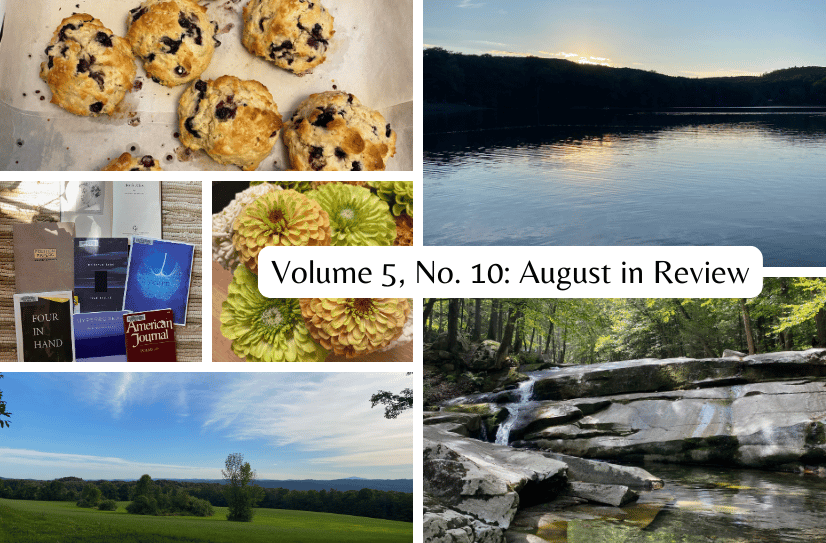
In this issue...
Sealey Highlights
This year was my 5th Sealey and, as always, it was a joy to participate in. I was also happy to be able to participate in the Open Books Sealey Challenge Poetry Pledge Fundraiser—collectively, we raised $23,461 for The Sameer Project! Thank you to everyone who donated.
I struggled with the Sealey this year, more than I usually do. Summer classes and the heat really took it out of me. But it’s still my most cherished reading tradition, and alongside a few meh books and some hard days, there were, of course, some incredible moments. I reviewed every book I read for the Sealey on IG—you can find all those reviews here! Below are some highlights from the month.
We Contain Landscapes by Patrycja Humienik (2025)
This collection entered me like water. This collection: “Do to me what sunlight does to a river.” These watery poems about womanhood and wanting, about immigrant daughterhood and longing, about how rivers move and what sadness feels like on the skin, these poems that know “how beauty exists with no regard for goodness or the living,” these poems that (under)stand the consequences of naming, these poems that shake with grief, these poems of knowing and unknowing, that understand “to try / to contain anything is // to rid it of water,” these poems that reach and reach for “belonging beyond possession,” and ask and ask “is we a home?” and “is we a longing” and refuse to be small and neat, these poems that wild and shapeshift and spill their love across boundaries, these poems that “bow to the ache,” that break it all open—language and lineage, shame and desire, time and its shadows, these poems that sing despite and despite, again, that “inherited devotion as a form,” that know “if belonging is form, / its constraints erode the land,” that don’t know anything except “failure, though, is essential to transformation,” these poems that are transformations of language and body, that refuse maps, that want so hungrily, that river, these poems.
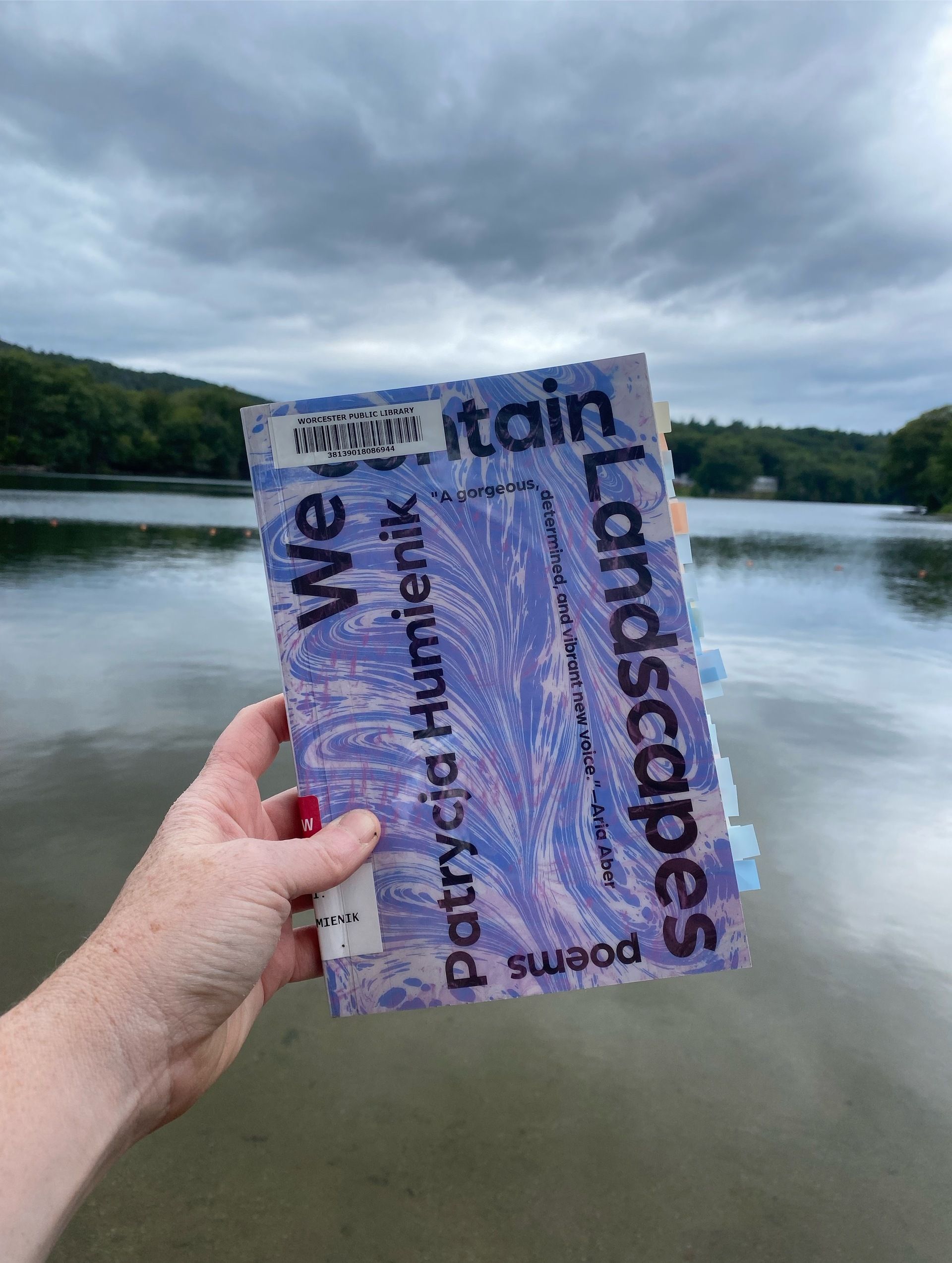
These poems invite the world in. These poems forever in the unnamed map of my body. These poems the questions I can’t stop asking. These poems the space between and between. These poems, a reminder: “I will not turn away from the ache of this world.”
“O tenderness, I’m walking toward you. / Why are you pulling away?”
These poems, refusing to pull away. These poems, the water my heart needed.
Poetry & Tea at the River
I spent several mornings during the Sealey with the river, my tea setup, and my book of poetry. Having tea by the river is one of my favorite rituals. There’s something about the kinship between the pouring and sipping of tea and the flowing and rushing of water. I also love the challenge of finding perfect rocks on which to arrange my tea things. I like arranging myself inside an environment and a place that isn’t mine, that’s bigger than me, that lives outside of me, but holds me.
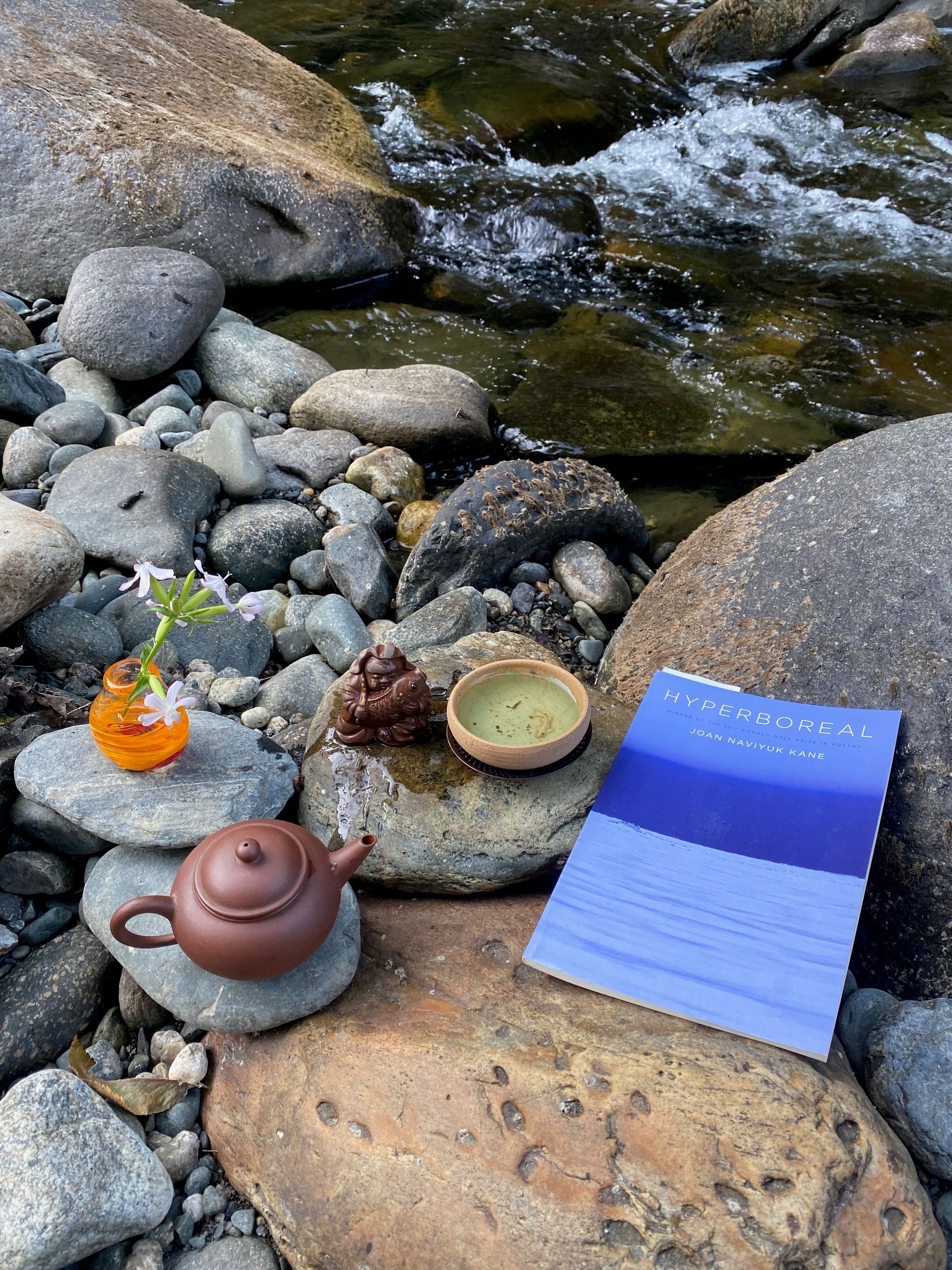
Mornings at Rise Above
One of the two classes I took over the summer was drawing foundations, which met twice a week from 9-1. I got in the habit of stopping by my favorite bakery before class. I’d order a bagel and settle in to read some poems. I often ended up writing more than I read on those mornings, as bits and pieces of the poems I was reading sparked images and ideas. I ended up writing a very long poem over several days, responding to the poets I was reading.
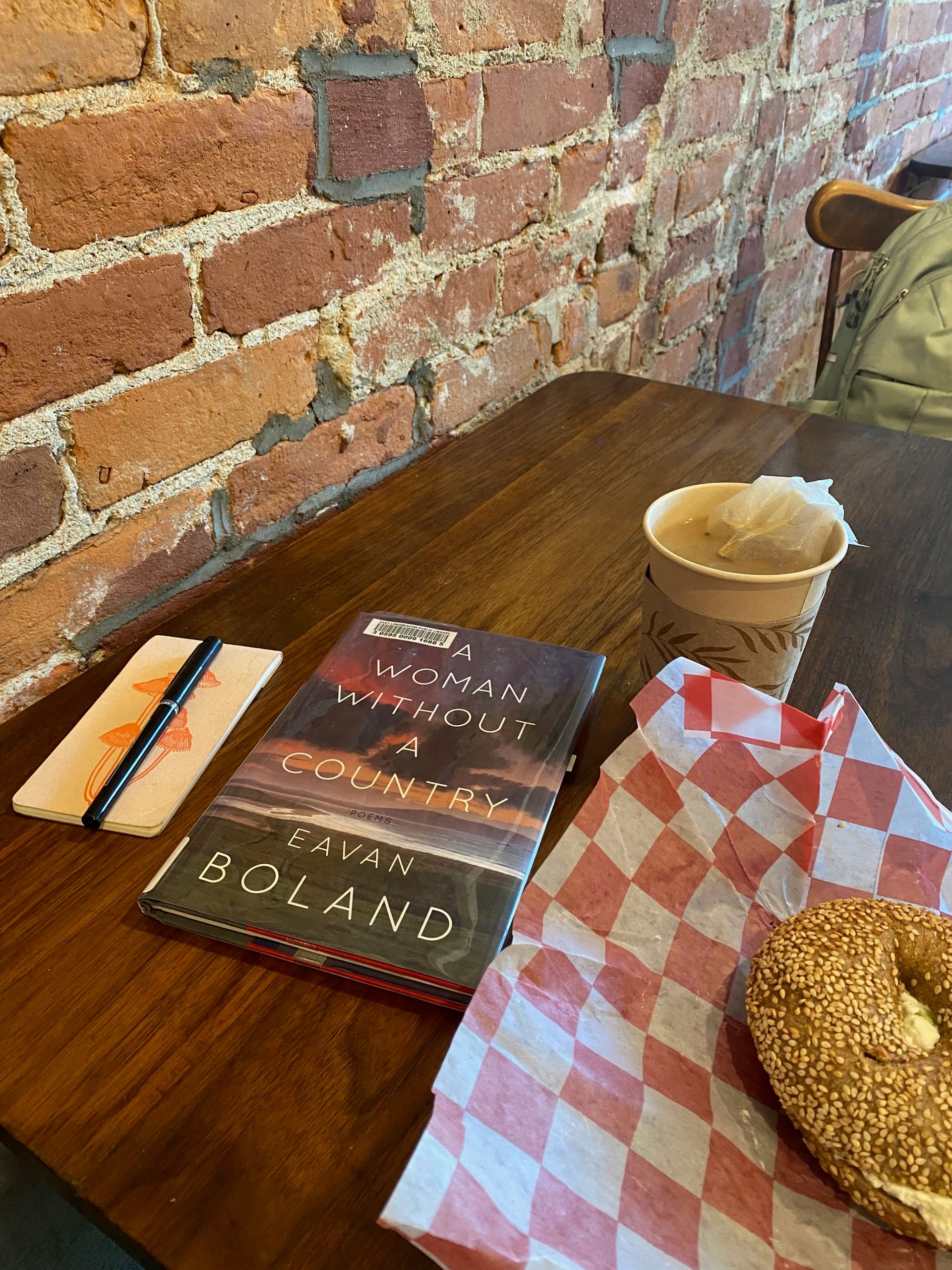
I still haven’t typed it all up yet, but I loved the process of continuing the same poem, in the same place, on different days, in different moods, inspired by the words of different poets.
Mary Oliver
I’ve read one book by Mary Oliver every month this year, so obviously I read one for the Sealey, too.
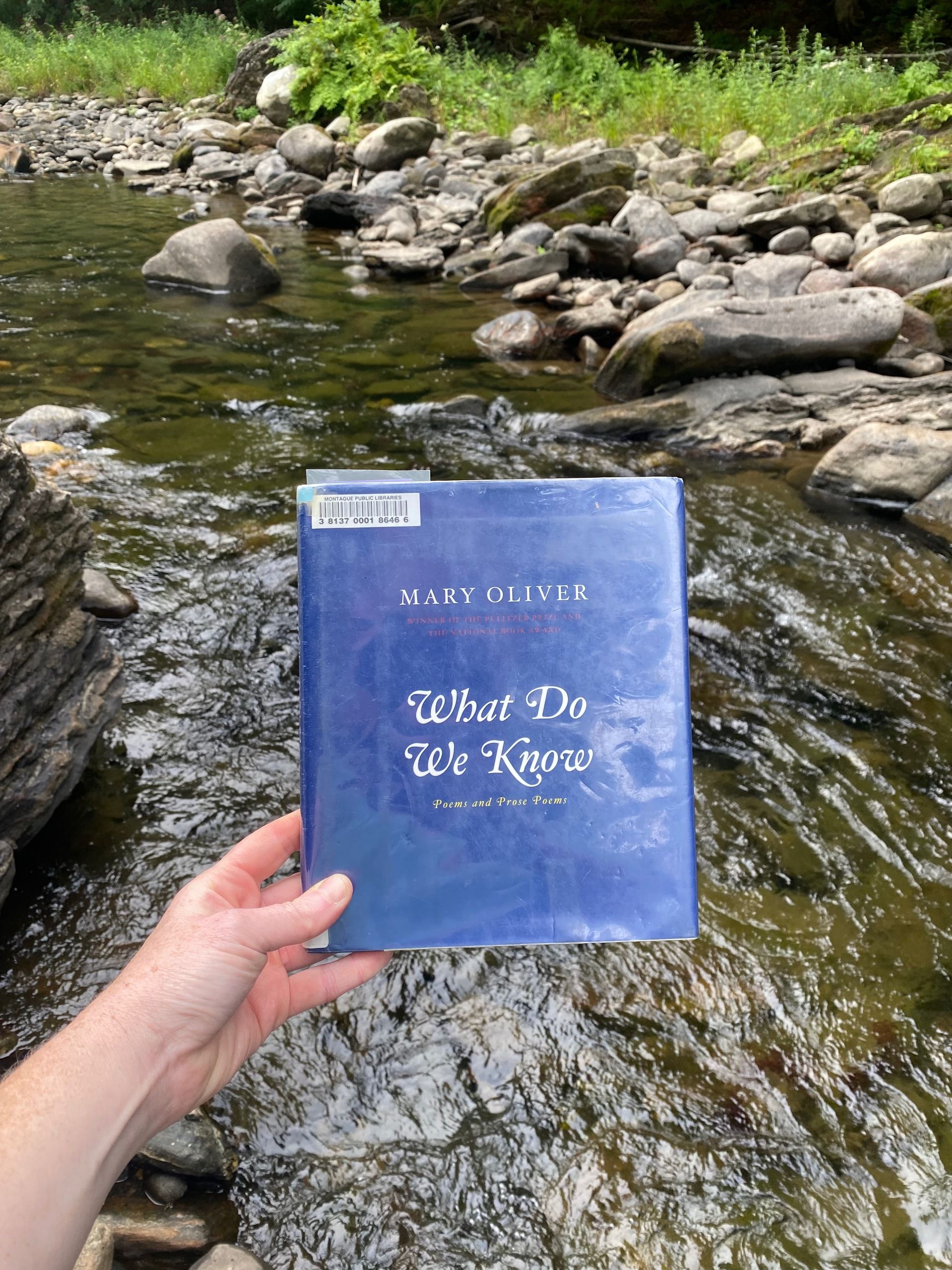
There is a certain way Oliver uses the word “world” that I am drawn to. In one poem here she asks, “But tell me, if you would praise the world, what is it you would leave out?” And I want to argue with her—the endless horrors—and yet I can’t, because I understand in my deepest places what she means: you cannot love the world without looking at it, and when you look at it, you will see so much that is impossibly bad, and still, she and I, we want to praise. In another poem she says, “Take care you don’t know anything in this world / too quickly or easily.” So I lie down next to my pup and feel her breath on my hand and watch her paws twitching and think: what do we know.
But here is the line that absolutely stilled my breath, from “Snowy Night”: “I love this world, / but not for its answers.”
Rereading Be Holding
I ended the Sealey by rereading one of my favorite poetry collections/poems of all time, Ross Gay’s masterpiece Be Holding. It’s not the work he’s best known for, but, in my opinion, it’s his best. This time, I listened to him read the whole poem while reading along, and I cannot recommend it highly enough. It is a world-changing experience.
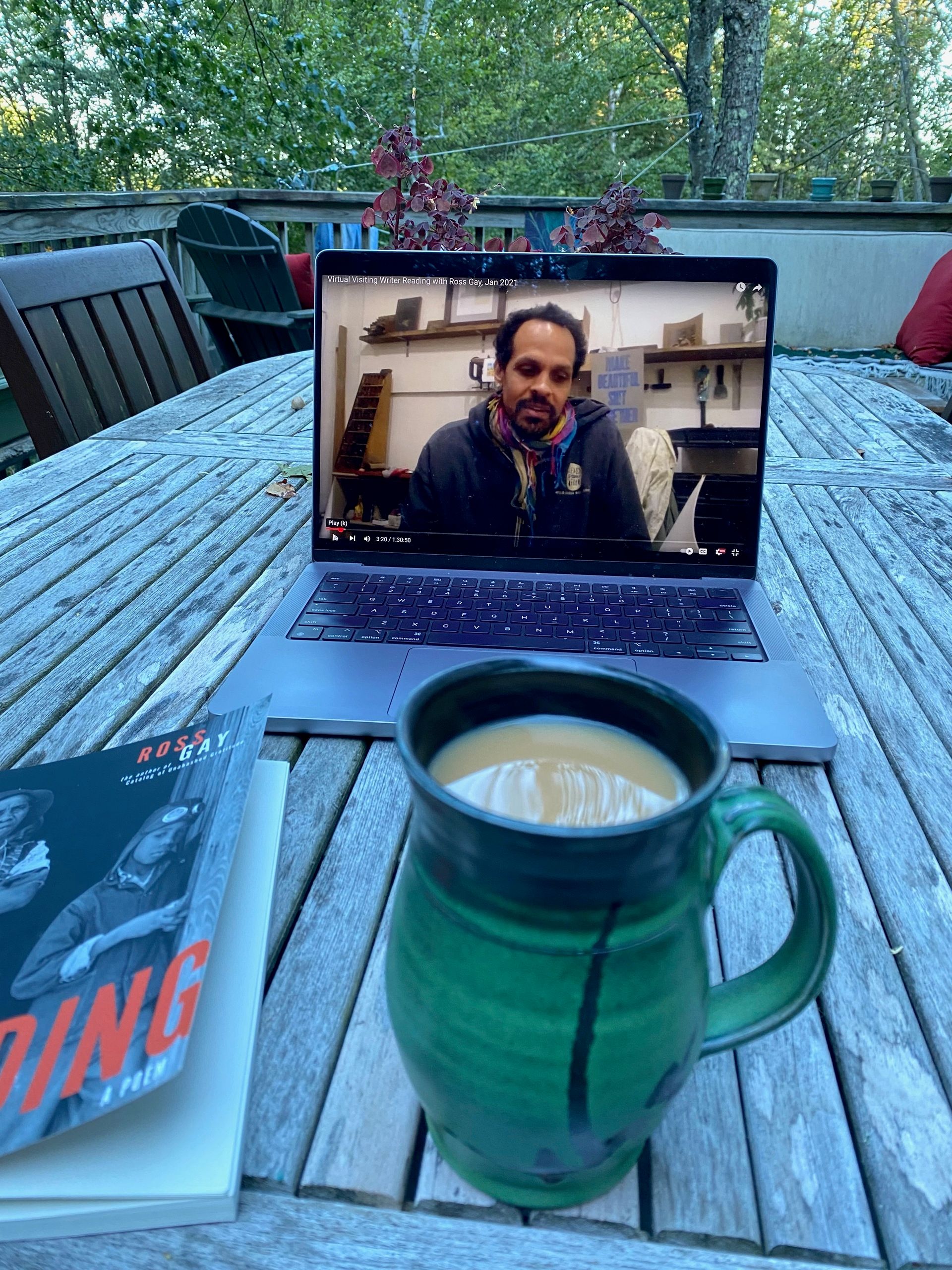
Really, this book is two poems: the book-length poem about one moment of flight, one moment during which basketball player Julis Erving, Dr. J, flew in 1980 (about flight, Black flight, the wake, being and beholding and looking and seeing and trees, about about about), and then the poem that is the acknowledgments, which is, dare I say it, also one of my favorite poems of all time.
I am so overwhelmed by the brilliance and heart of this poem in this moment, after hearing Gay read it for the first time, that I don’t think I can really write about it with finesse or clarity. The things he does in this poem—the transformation that occurs—it is something I have never experienced in any other poem. It astounds me. It happens in my brain—I could spend the rest of my life studying the making of this poem—and it happens in my body. I can’t read it without sobbing. I can’t read it without something wild happening to my breath.
Instead of trying to write with clarity I will tell you about one thing, one little—world-sized—thing that Gay does, which is that, in this 98-page poem, written in centered couplets (a shape I will never stop thinking about), there are 7 periods. Not zero periods, which would be a different thing entirely. Exactly 7. And those 7 periods come in clusters—the first 3 on page 39, the 4th and 5th (in one line!) on page 40, and the final two (6, 7) in two lines on page 59. Every single one of these periods comes in a line about breath. Most often they come after the word “breath” or “breathe” but sometimes after breath-related words, as in: “Come on now. Breathe.”
And when you read the poem, when you read what is happening around and among these small clusters of periods, you will feel these periods and what they are carrying in your body. And you will also feel—I am sure you will, I don’t know how you couldn’t—what these periods do to the final line of the poem after which there is no period, “we breathe”—you will feel in your body as I do, as I have been feeling since I first read this poem in 2023, how those 7 periods make this last utterance, this last “breathe” fly, how the poem ends in flight, there are a thousand more words to say about it but these are the ones I have, the weight of those 7 enormous periods making this poem fly—
I also want to tell you about how the book—not the book-length poem, but the book, the one that contains two poems, begins and ends with the words “Bound in gratitude.” These are the first words after the copyright page and the last words after the acknowledgments poem. And if you’re thinking I could write a whole essay on that sentence and this fact, you’d be right.
From the acknowledgments: “A poem’s practice, the practice of poetry, must always defy the logics of property.” Ross Gay. Bound in gratitude.
Queer Family Forever and Ever Amen
Toward the end of August, my cousins came to visit for a few days. I live alone, which I love, and while I do have friends over on the regular(ish), it had been a while since people I love stayed in my house, and it was such a gift. We had a luxurious breakfast on the porch and a magical picnic at one of my favorite waterfalls. One night they made me dinner. I took them to my two most beloved swimming spots. We laughed and laughed playing a hilarious word game. In the midst of a hard month, this visit was so nourishing and needed.
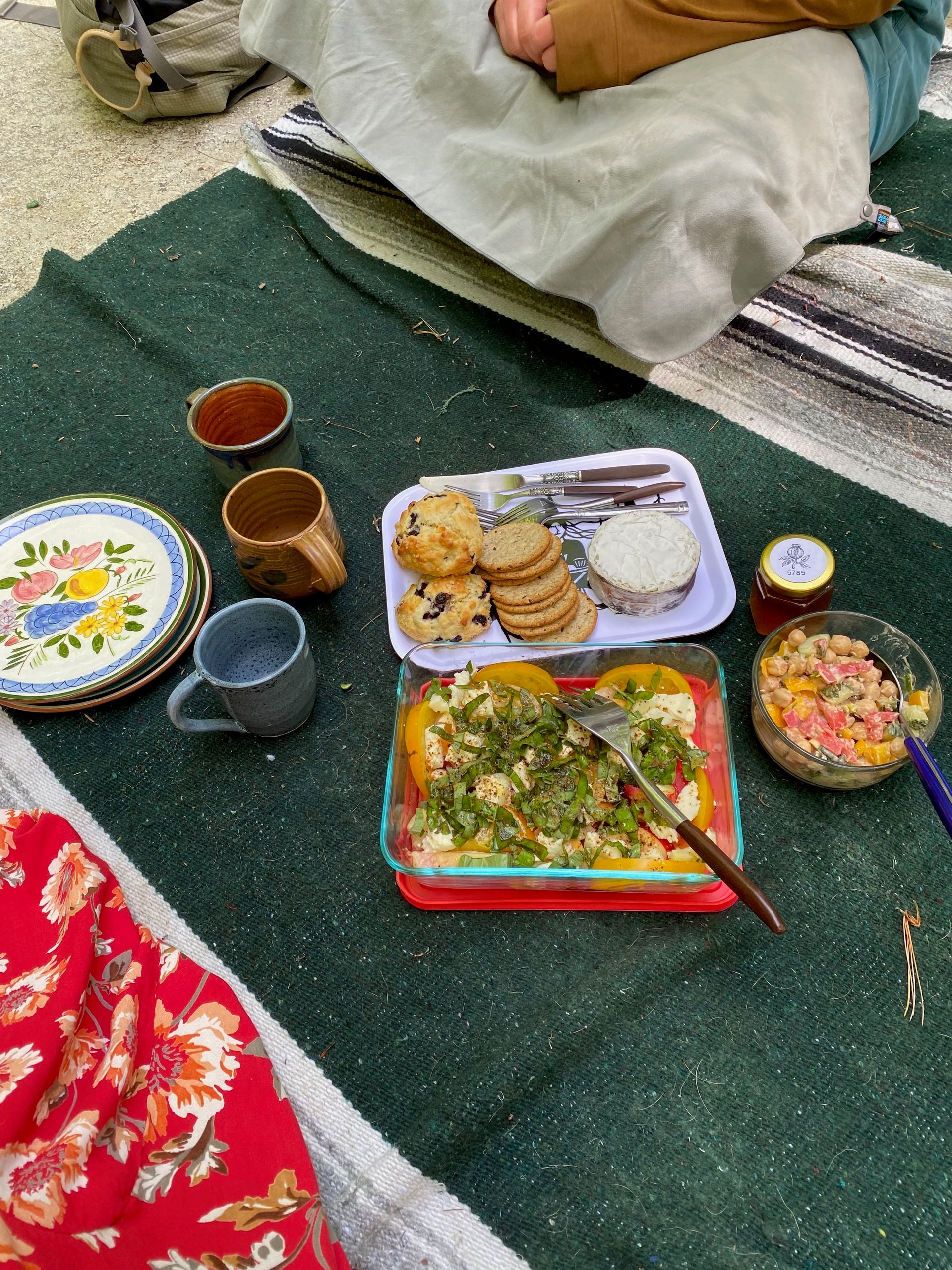
I feel almost outrageously lucky to have queer people in my family of origin. It’s something I grew up with, something I was born with (hi to my beloved gay aunties!) and sometimes that means I take it for granted. But it’s not something I want to take for granted. It’s something I want to cherish for the miracle it is, for the way it has made me who I am.
New Swimming Spots
I have my lake and my spot on the river, two bodies of water I love beyond words. They are both so perfect that I’m rarely motivated to seek out other swimming spots, despite living in a place absolutely chock-full of gorgeous streams, rivers, lakes, and ponds. But recently a friend mentioned one of her goals for the year was to swim in 10 new-to-her spots, and that inspired me. I’m not sure I’ll make it to 10 by the end of the swimming season, but I’ve been enjoying branching out a little bit.
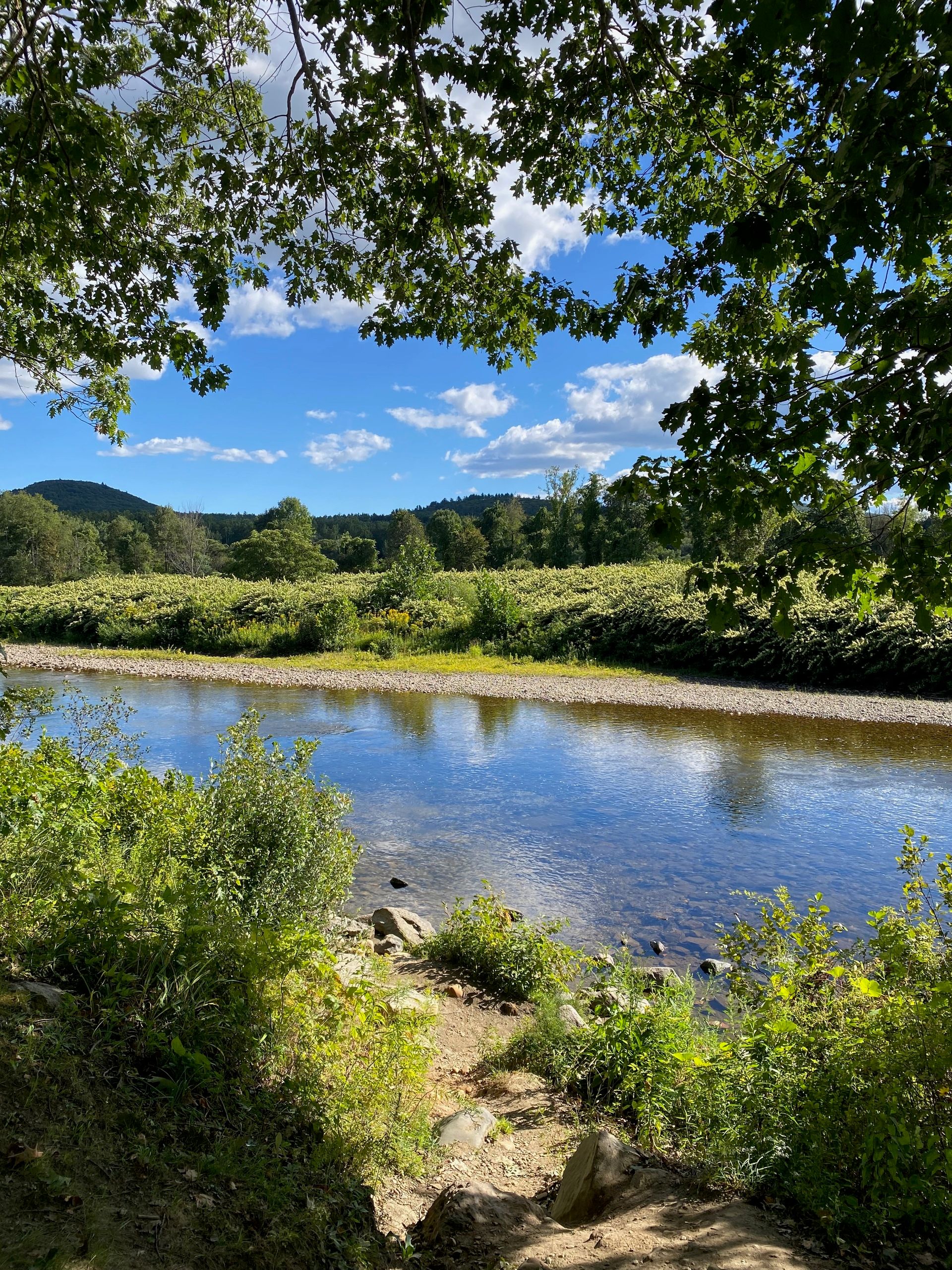
The Deerfield River on Route 2 in Charlemont
On the way home from The Clark Art Institute in Williamstown, I pulled over at a picnic area on Route 2 in Charlemont. I’ve driven past this place many times, but never stopped. The river here isn’t super deep, and it was flowing quite fast when I was there, and it’s also right alongside a busy road. So it’s not going to become a new favorite spot. But the water was lovely and I was happy to submerge myself in a new-to-me river!
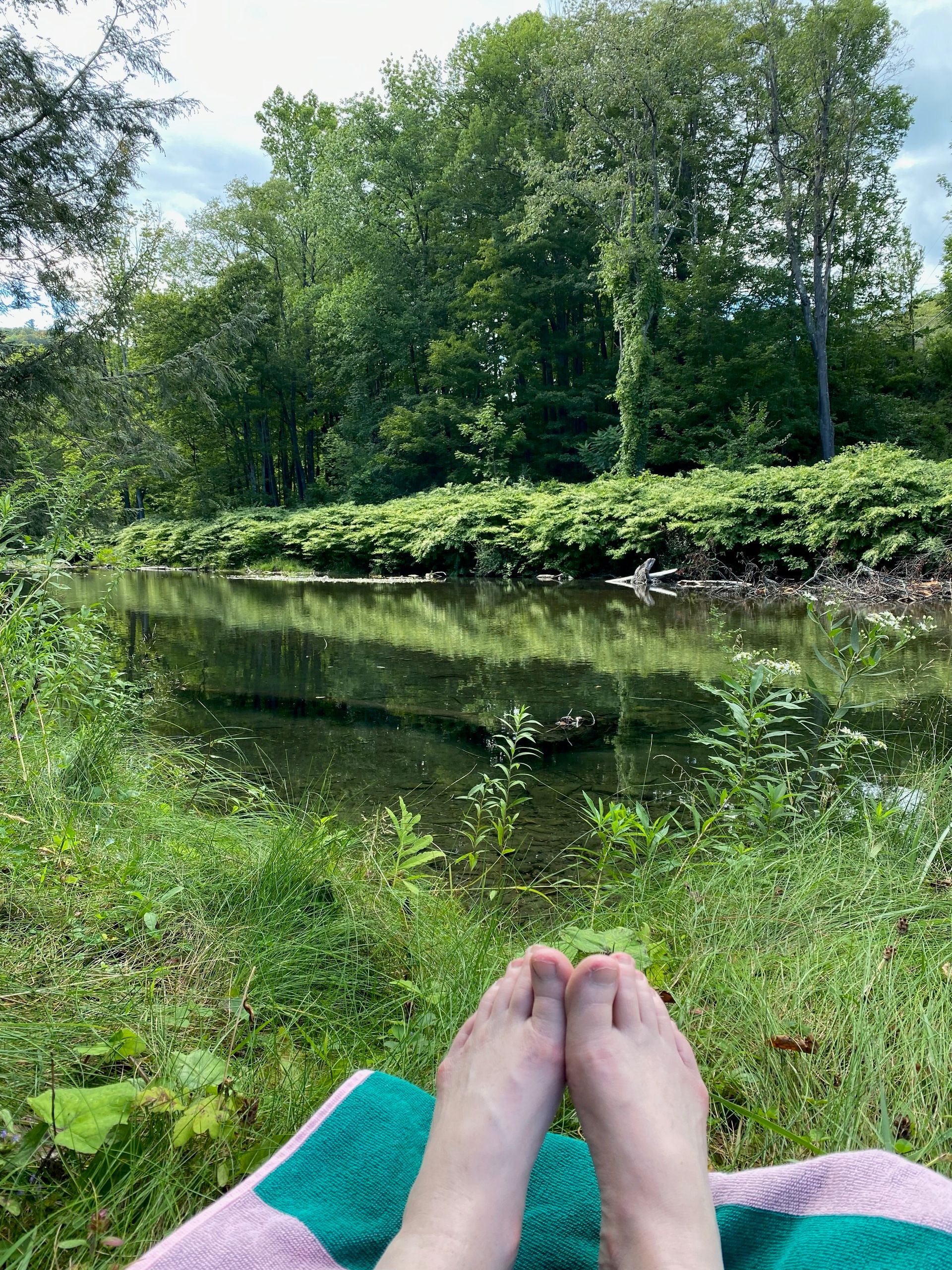
The Green River near the Green River Covered Bridge in Guilford, VT
Friends have been telling me about this spot on the Green River near the covered bridge for a while now. It’s a few miles up the road from my beloved spot, and as far as the swimming goes, it doesn’t compare. But there is a gorgeous park next to the dam and covered bridge, and it was a perfect place to sit for a while watching the water and the sunlight. I will definitely be going back!
I Have A Lot of Feelings About Curation
In the week between the end of summer classes and the start of fall classes, I took a little staycation, during which I went to three art museums. I have become, in a very short amount of time, completely and totally obsessed with curation. I am fascinated by museums—both their long history of colonial and imperial violence and the radical possibilities they (might) hold. I’ve been thinking a lot about how so much of curation is about what isn’t displayed, what isn’t chosen. It’s about the choices made around silence and invisibility. What stories are missing, and how do we make those missing stories visible? How does curation implicate its practitioners? How do we draw attention to what we can’t see?
I went to The Clark Art Institute for the first time had so many feelings. I have so many feelings about art! I could fill 100 newsletters! I’m only going to share a tiny fraction of everything I’m thinking and feeling here, but I do have plans to see many more exhibitions this fall, and I’m sure they’ll make an appearance in the newsletter.
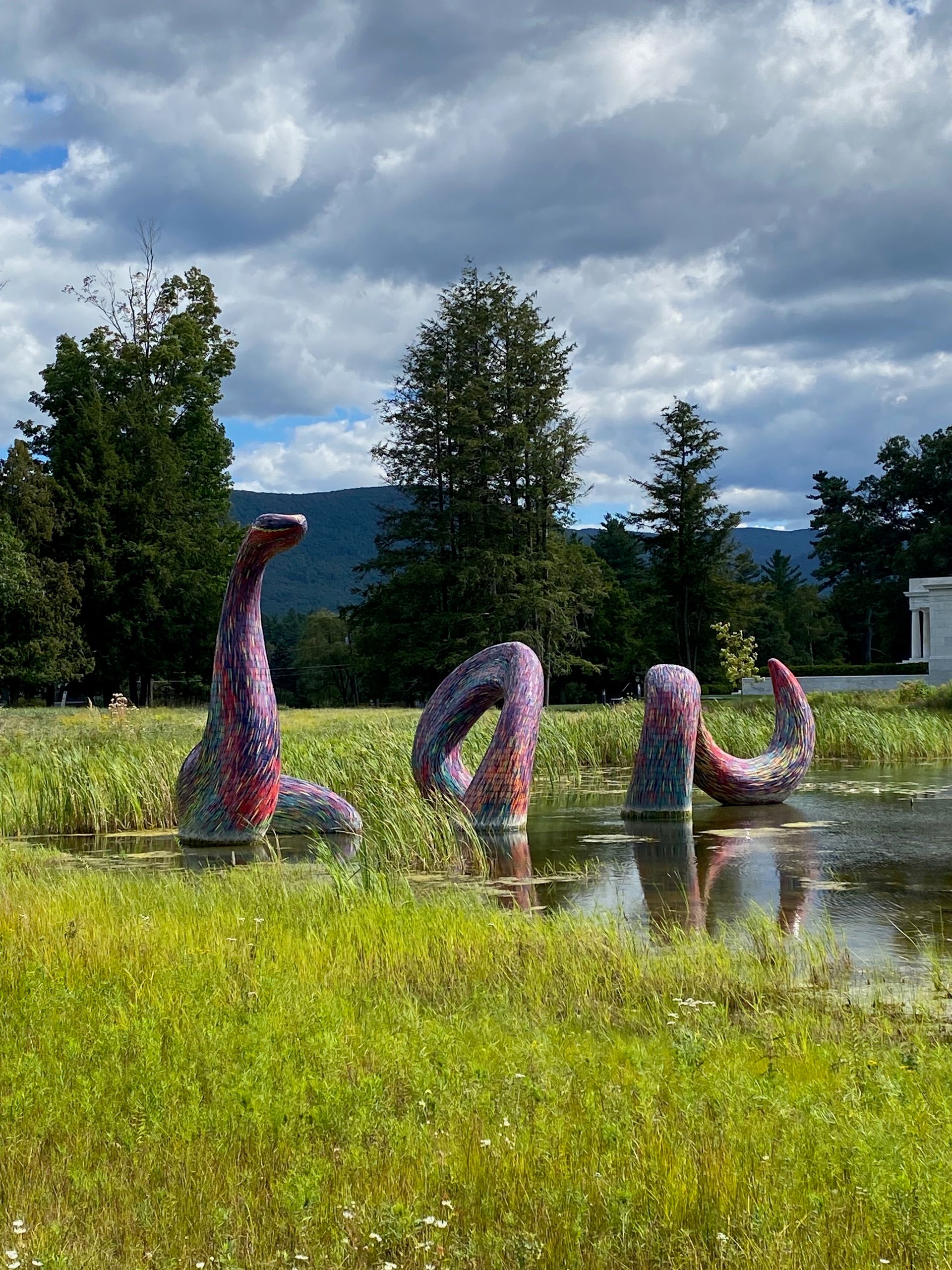
Javier Senosiain, Coata III, part of the outdoor installation Ground/Work at the Clark
I saw two exhibitions at The Clark, one I loathed and one I loved. The one I loathed was called A Room of Her Own: Woman Artist-Activists in Britain, 1875-1945.
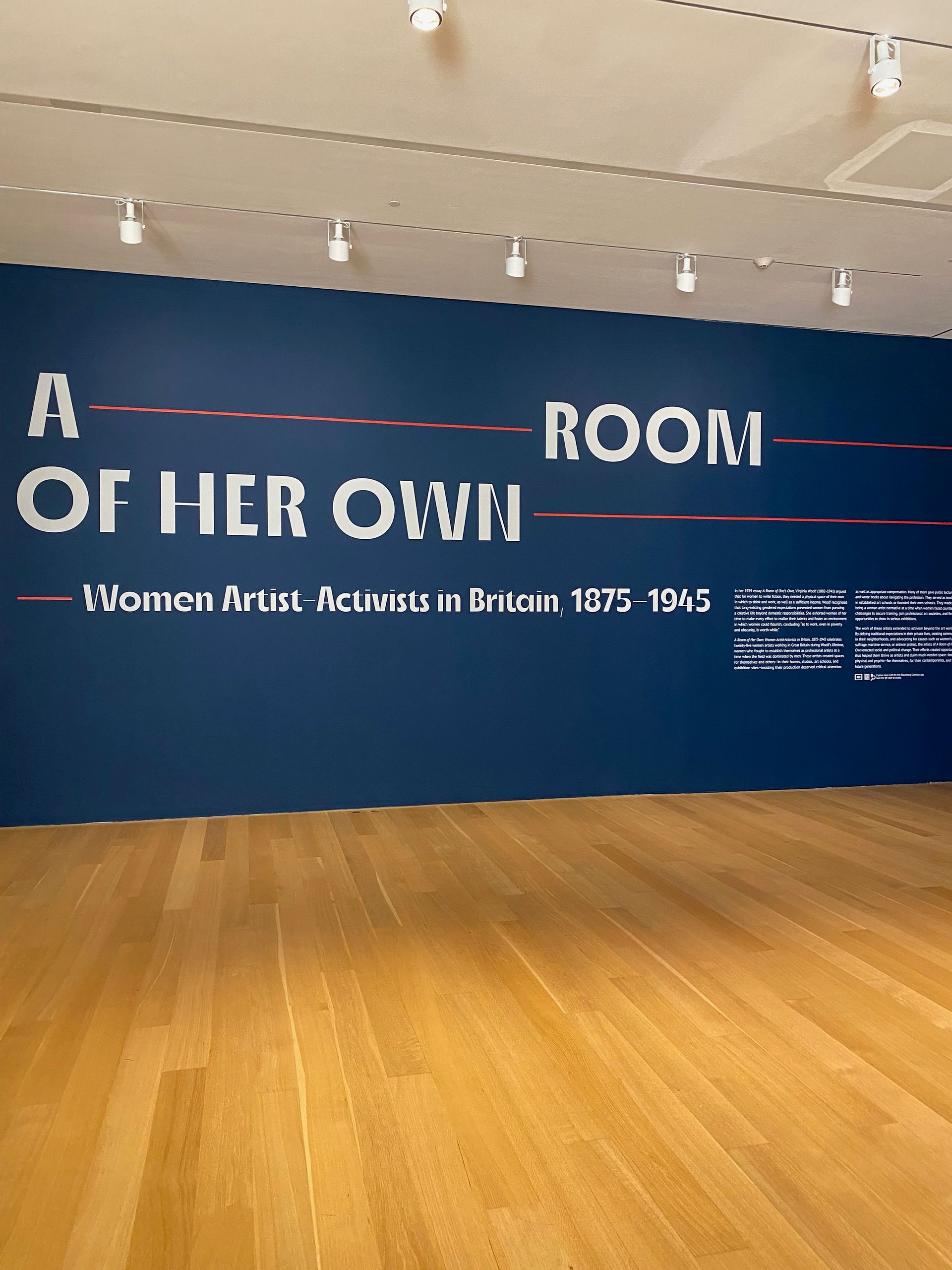
The exhibition featured the work of 20 British women artists. How many of them do you think were white? 100%. How does the curator of a show like this sleep at night? All the artists were white and, as if that weren't bad enough, there was not a single mention of race—or the existence of the British Empire—in any of the exhibition text. I know most art museums aren't known for their critical engagement with history but I was still shocked. How do you make an exhibition about women artist-activists in Britain in the first half of the 20th century and not mention the British Empire? It’s like making an exhibition about the United States in the 19th century and simply not mentioning slavery. There were a few pieces that I might have enjoyed in another context, but I was so angry I couldn’t actually see what was in front of me. I could only see what was not there.
There was only one piece in the whole show, a print by Gwen Raverat, that depicted a non-white figure. (Though, I was so angry I could have missed something.) Because there was no discussion of race in any of the exhibition text, this print, then, became the only mention—an implicit mention, unremarked upon—of race in the entire exhibition. An exhibition about the history of women artists and activists in Britain between 1875 and 1945. A time when—oh, you know, race played a role in the art, culture, history, and politics of the country.
Maybe this seems like a small thing—just one exhibition! But it's not a small thing. This is part of how we got here. There was so much violence in that room—ghosts of violence, unspoken violence. The curatorial choices were a silencing that became the only thing I could hear.
The exhibition I loved was Isamu Noguchi: Landscapes of Time. Noguchi is a very famous sculptor but, unsurprisingly, I had never heard of him, and I was completely dazzled by his work.
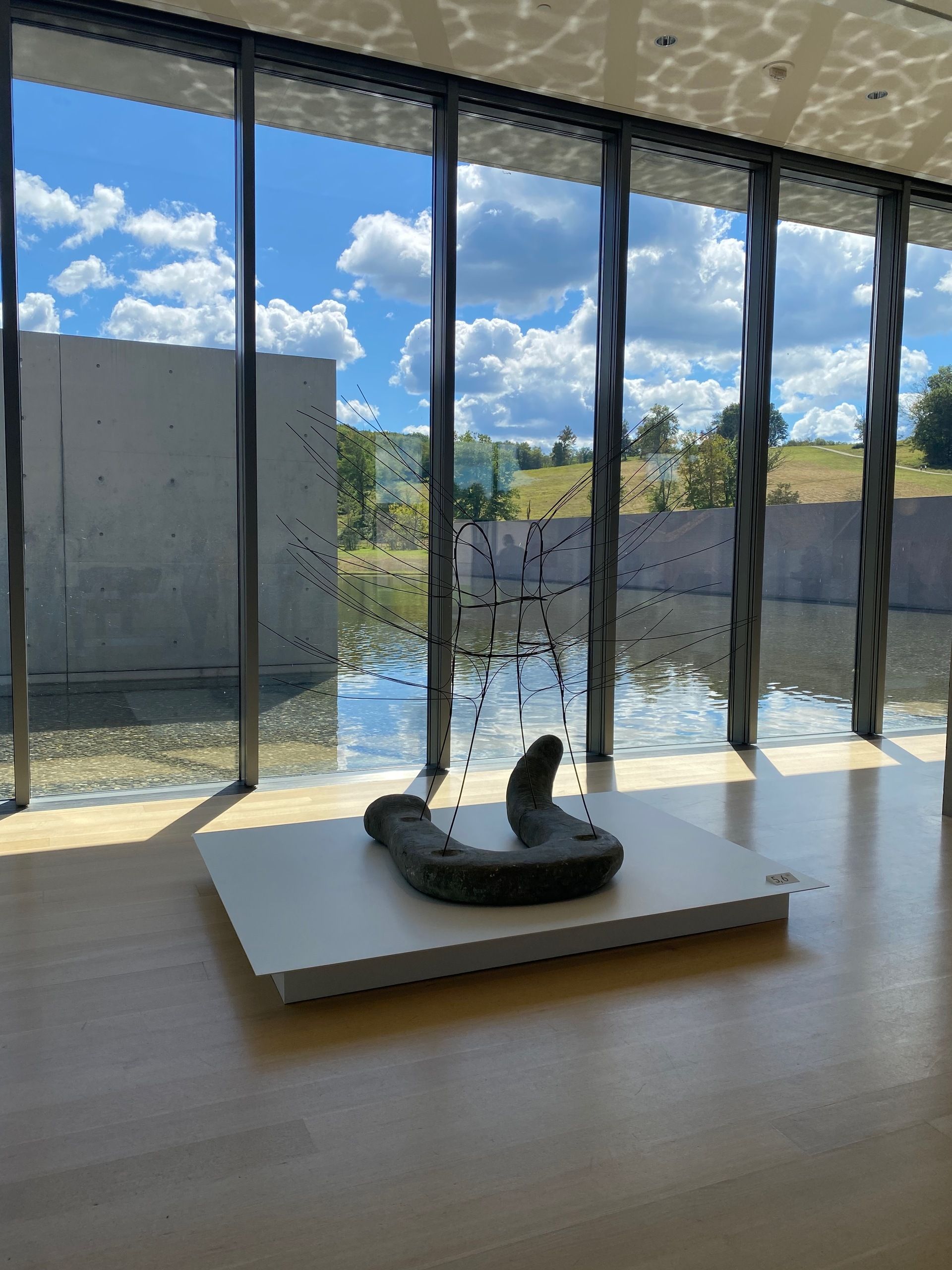
There is so much I loved about this exhibition, but I was most struck by its design. Noguchi worked in various mediums, including stone and wood, and most of the pieces in this show are large—basalt sculptures, marble slabs, river boulders. The pieces are also all about time: how it works on materials, how it works on humans. The exhibition was set up in a room with huge banks of windows on two sides, and so it felt like the outside world was a part of the show itself. The pieces were in conversation with their environment: a bank of windows directly in front a reflecting pool. Despite the small room being somewhat crowded, I felt a profound quiet moving through it. The placement of each piece in relation to the windows added to their presence.
The only text in the entire room was an introduction to the show on one wall. Rather than wall-mounted text naming and describing the pieces, they were all labeled with a number. All of the accompanying information about each piece was available in a catalog. I loved the way this centered the art, the way it forced me to approach each piece with a sense of mystery and openness. I am drawn to text, and I sometimes struggle, in museums, to look at a piece before reading about it. In this case, it felt natural.
A Room of Her Own is closed, so happily you cannot subject yourself to it, but the Noguchi exhibition is open through mid-October. If you’re local, I can’t recommend it enough!
A Day in Brattleboro
During my staycation, I spent a day in Brattleboro. Brattleboro is 20 minutes from my house. It’s home to my favorite local bookstore. It’s a part of my place, my landscape, somewhere I go often. But I approached it like a tourist, like I would have if I’d traveled to some distant city on vacation. I cannot recommend this enough! I don’t think we act like tourists in our own places enough—or, at least, we don’t enact the genuine and good impulses that can (but often do not) underpin tourism: wonder and curiosity. My day trip to Brattleboro felt like a special, indulgent adventure (and it was!) but it also reminded me how much I love where I live, how lucky I am to live here, how much beauty I am surrounded by. It connected me, more, to here.
I started with breakfast at the Guilford Country Store. I pass this place literally every time I drive to Brattleboro, but I had never stopped. I adore country stores! It’s hard to explain the particular vibe of country stores in New England, but you know it when you feel it. It was the perfect place for a breakfast sandwich at a sun-drenched table surrounded by people reading the paper and/or chatting.
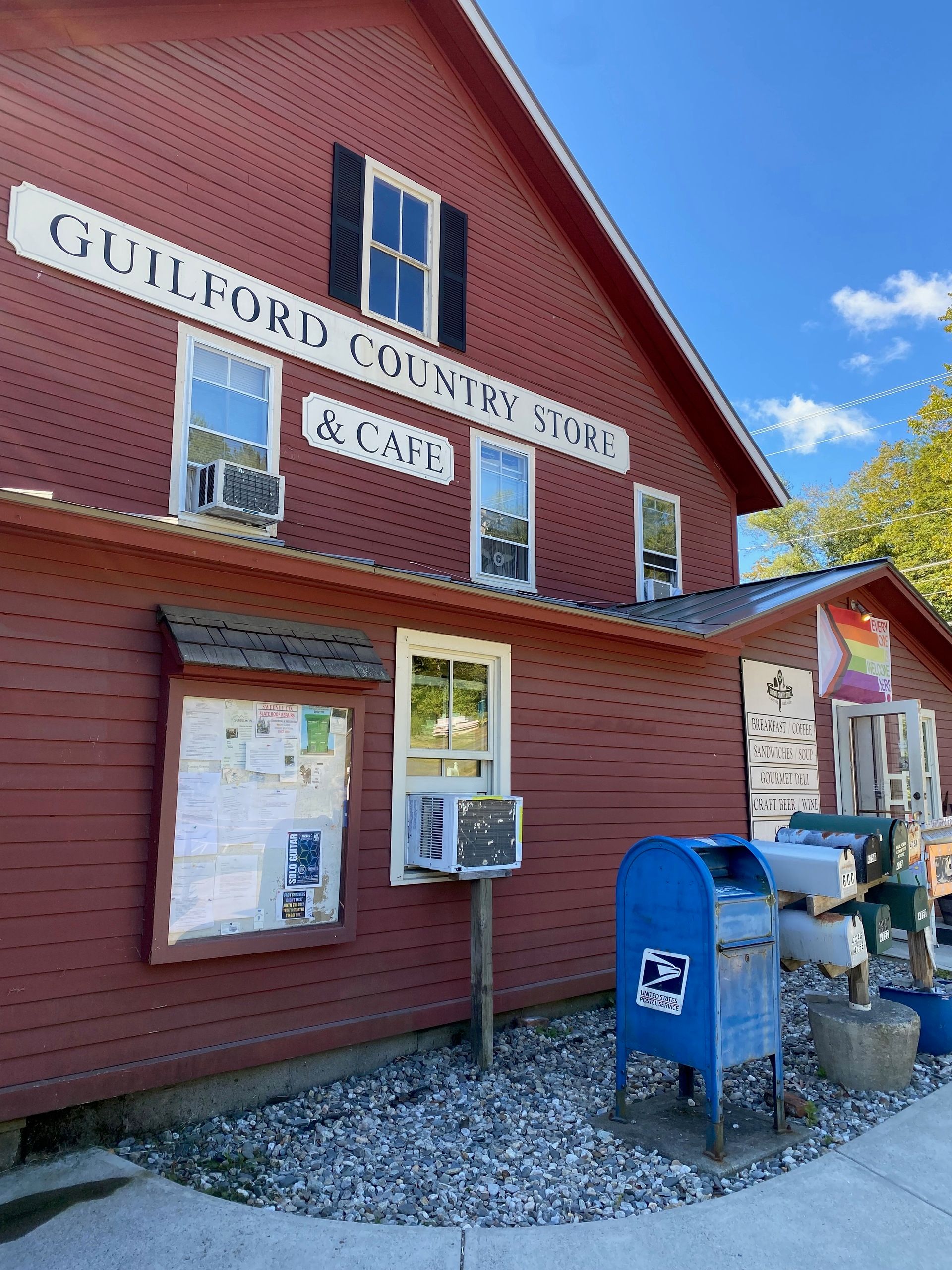
Next I went to the Brattleboro Museum and Art Center. I adored this museum! It’s the perfect size—two main galleries and a few smaller ones. I spent an hour and a half there and was able to leisurely look at everything. I didn’t love every exhibition, but I loved the range of different kinds of art, and appreciated the focus on work from local and regional artists. It’s pretty incredible to walk into the Smith College of Museum of Art and see an Alma Thomas painting, but it’s just as wonderful, in a different way, to see the work of lesser-known artists.
One of the most beautiful things I saw there was this divining rod installation by Michelle Samour in the group show Making Space. The photos I took don’t capture the quiet beauty of this piece at all—if you’re in the area, it’s up through November 2nd!

However, my favorite exhibition in the whole museum was Glasstastic 2025, a collaboration between kids and adult glass artists. Kids drew imaginary creatures, wrote descriptions of them, and sent them to BMAC. Then 21 glass artists selected (how? an impossible task!) one creature each, which they then recreated in glass. If you click on the link above, you can see the drawings, descriptions, and glass creatures. I promise you will not regret it. It is the best thing I have seen in some time.
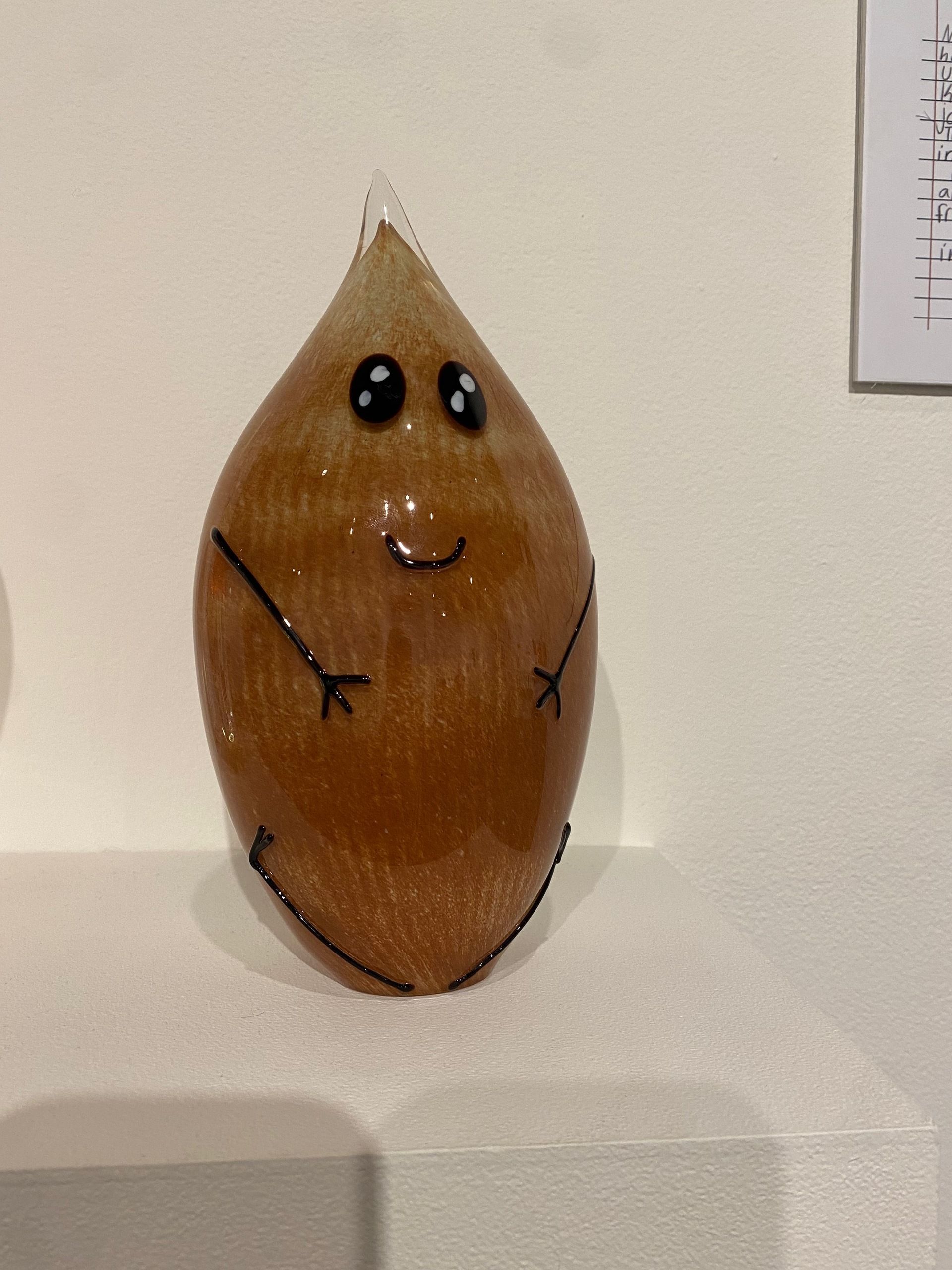
Next I spent a few hours on the West River near the West Dummerston Covered Bridge. I love my spot on the Green River, but swimming in the deep, cool water under the bridge, surrounded by mountains and the rushing of the water and patterns of sunlight on the rocks—a dream.
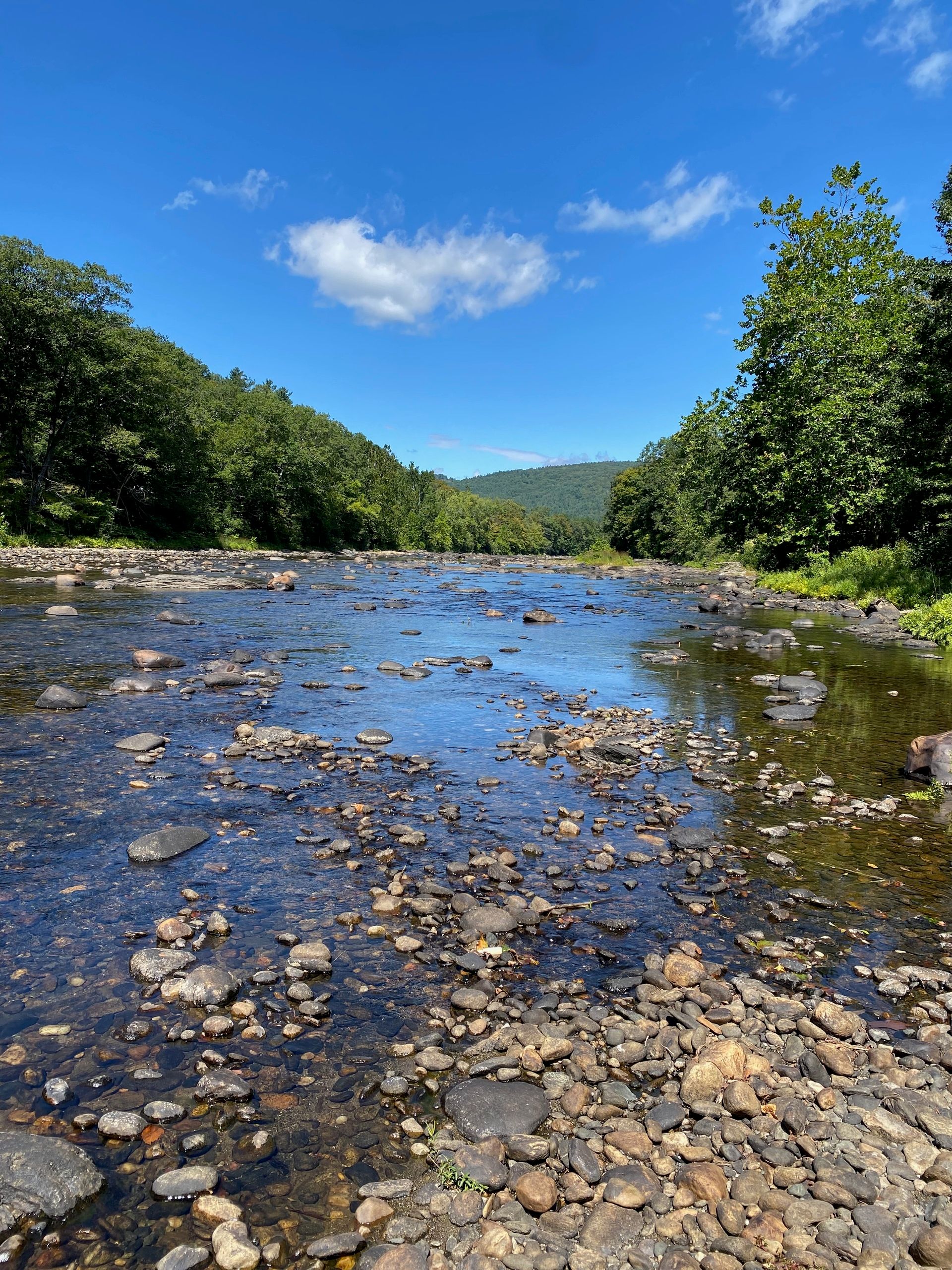
Finally, I got tacos and elote for lunch at Crossroads Food Trailer, which I highly recommend. 10/10, I’m pretty sure this is the best view from a restaurant in Brattleboro. (I haven’t done extensive research, but I still feel pretty confident.)
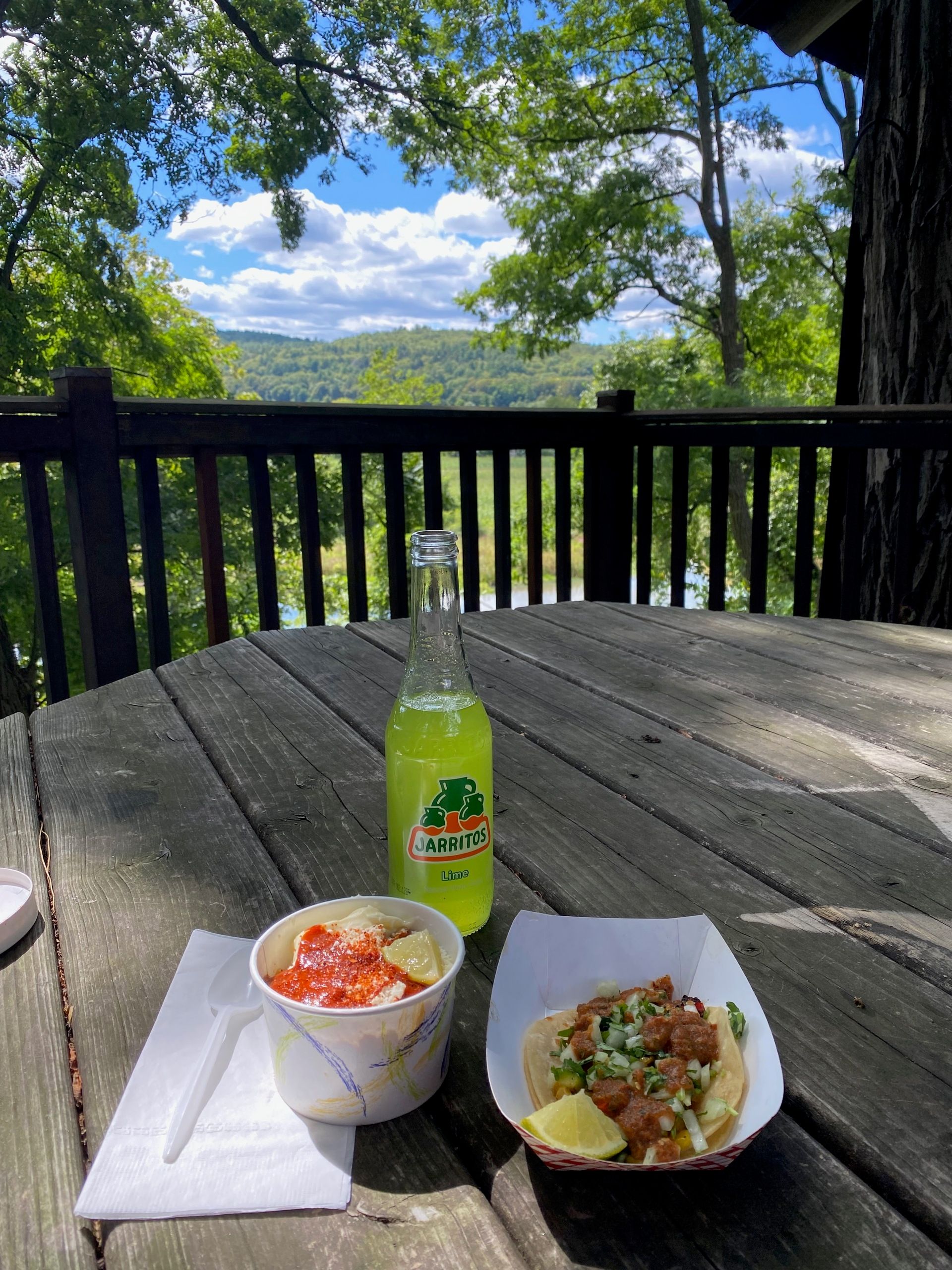
Not pictured: I stopped at Everyone’s Books to pick up my preorder of one of my most anticipated books of the year, Unfurl by Eli Clare, his first since 2017! I can’t wait to read it. Finally, on my way home, I stopped at the very sweet Wild Carrot Farm, where I got some tasty cheese and the first apples of the season. Thank you, Brattleboro.
A Favorite (Non-Poetry) Read
My in-person book club read Woodworking by Emily St. James in August and I absolutely loved it. I haven't been able to stop thinking about it since I finished, and one thing that has stuck with me is how solidly hopeful it is. It doesn't paint a rosy picture of the world. It's set in South Dakota during the 2016 election, and we all know that things have only gotten worse for trans people across the U.S. since then. The trans women in this book face very real violence. One of the main characters, Erica, is afraid to come out, and for very good reason—she knows what might happen if she does. It's hopeful not because St. James ignores any of this, but because the characters find each other anyway. They refuse to disappear. They choose life on their own terms. Not everyone survives times like the times we are living through right now. But some of us do. These characters do. And that means something. That matters. This book is an earnest love song to trans women and the messy but vital communities they create with and for each other. That matters.
Drawing is Hard
I took a drawing class! It was hard! In the weeks since I finished the class, I’ve been thinking a lot about what I’ll carry from it into my life. I did enjoy keeping a sketchbook and I did enjoy learning (beginning, attempting) a new skill. I liked the way observational drawing made me pay close attention. I liked thinking about how to translate the world visually. But I do not like representational drawing! I’ve been so excited about making visual art recently, and part of the reason I wanted to take the class was to see if I might fall in love with observational drawing. I’ve never been good at it, but not being good at something (especially something you’ve never tried to learn) is not a reason not to do it. What I learned is that, no, I don’t want to put time into getting better at representational drawing, but yes, I do want to keep making art.
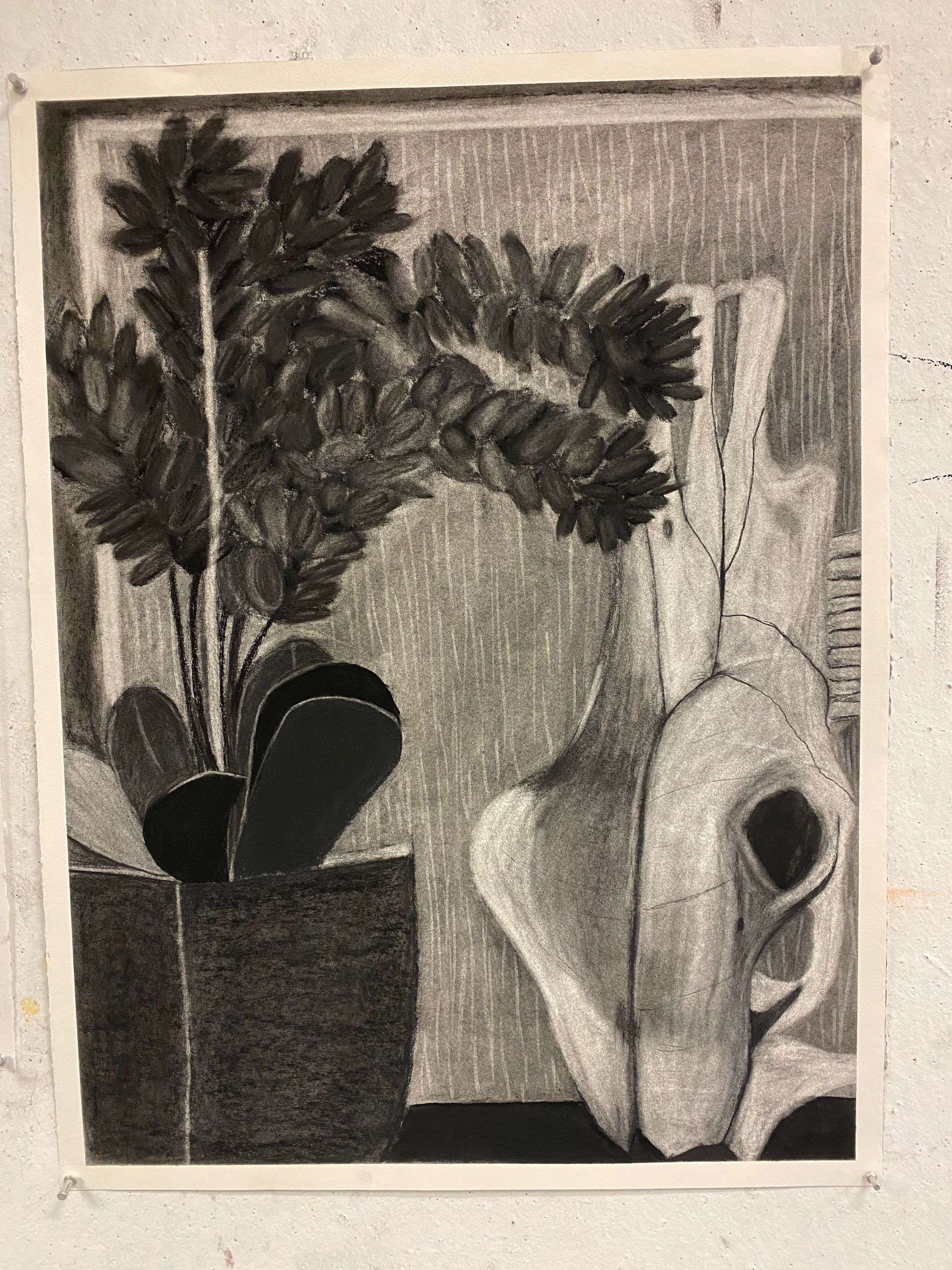
A still life I drew - plant and skull.
I’ve found a lot of joy in playing with visual art in the last year. I’ve also found a lot of joy in writing poetry, but it is a completely different kind of joy. With visual art, whether it’s collage or printmaking or a sketchbook or a wood sculpture or a book, I’m not invested in the outcome. I don’t really care what it looks like. It’s a form of play. It’s all about the process. With poetry, it’s also about the process and, honestly, the process—the actual making—is, I think, the most important part of the whole thing. What the making does to me. But I also care about the outcome. I care about the finished poem, about what it does, how it feels, how it moves in the world. I am invested in the making and the thing that’s made.
I’m also invested in getting better at making poems. I have ambition. I’m not talking about career ambition. Yes, I want to publish a book. That’s the goal. But that goal is in service of the poems in the world, of them doing something bigger than me. I’m not interested in awards and accolades. The ambition I have is for the work itself. Carl Phillips talks about this in his amazing book My Trade is Mystery.
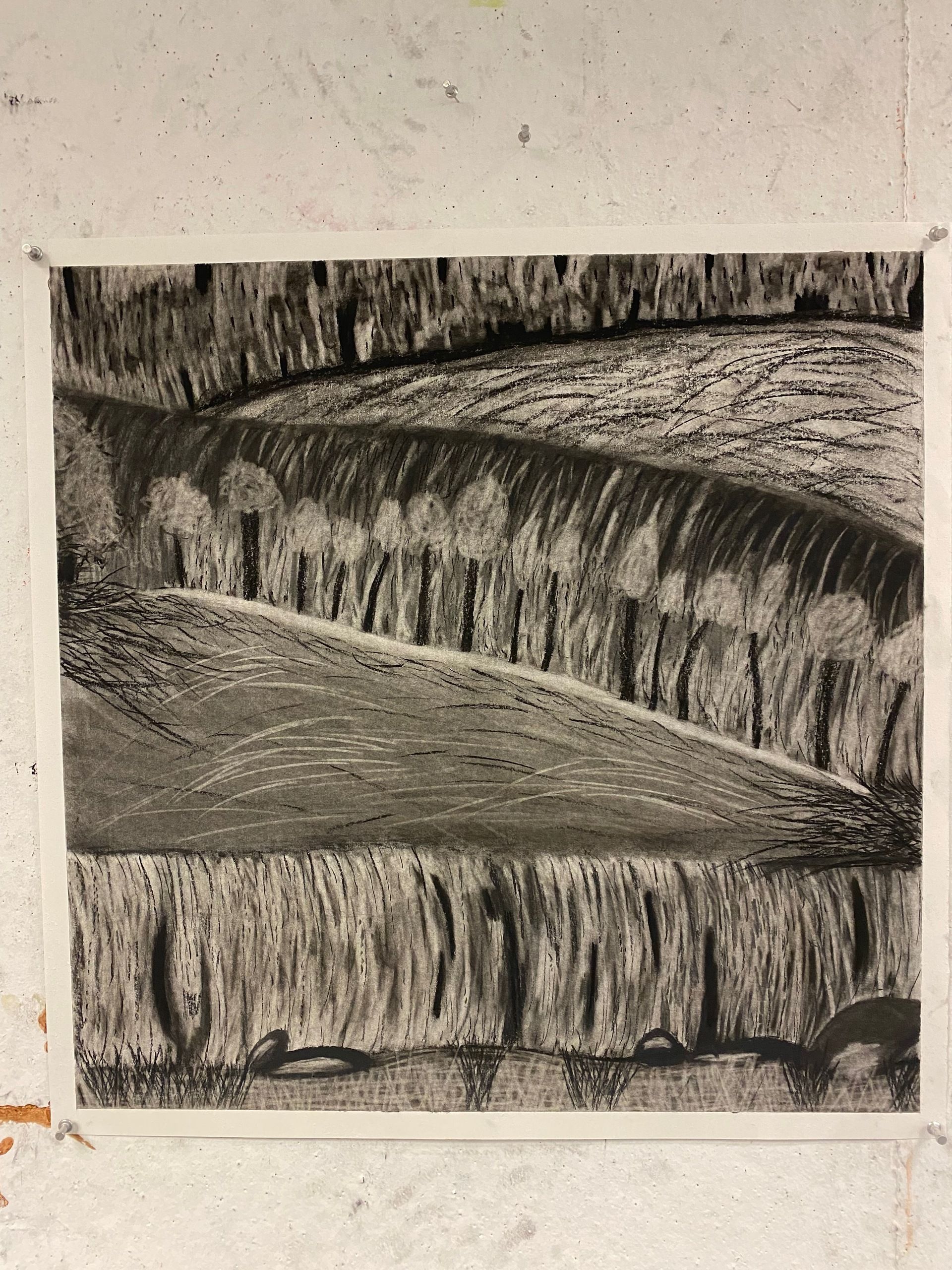
An abstract landscape. I drew two birch trees, flipping the paper upside-down after each one. Then I flipped the paper again, so that both trees were horizontal, and turned it into this. Playing!
The poem seeks to capture the light as it hits a given facet—but that doesn't describe the whole, just a fleeting piece of it. Ambition understands that, and refuses it. Each time I write a poem, I feel as if I've laid something to rest, arrived at the stability of having understood a thing. But the satisfaction is temporary, since what I sought to hold in place is as restless as I am. So, whatever the poem has succeeded in capturing, it's also failed to capture every aspect. There lies the defeat I spoke of. But ambition, instead of seeing defeat as failure and succumbing to frustration, treats defeat as a necessary step toward the next poem that will surely, this time, get it right. Except there is no right. There's just the ever-questing-forward, believing as firmly in art’s powers of resolution as the knights of old believed, apparently, in the Holy Grail. In this way, ambition is a form of faith, a belief in any given subject's knowability, a belief in art's ability to know.
Writing poetry, for me, is the ever-questing-forward. It’s how I find the questions that lead to the next questions that lead to the next questions. When I say I want to get better at making poems, what I mean is that I never want to come to the end of making poems. I want to keep going deeper and deeper into that making, for the rest of my life.
Revision is another word for this particular kind of ambition for the work. This includes not just the usual idea of revision—changing a word here, adding a semicolon there—but revision as a new way of seeing, what the word means originally, to see again but also differently. What does using long lines to grapple with an idea look like, versus using short lines? What different thing will be revealed, what same thing will be differently revealed?
Drawing is not this way for me. I don’t want to go deeper and deeper into the drawing. I don’t want to keep asking new questions. I just want to play. My favorite drawing I made is this self-portrait study, a blind contour drawing where I had my eyes closed and was feeling my face as I drew, not looking at what I was putting down on the paper.
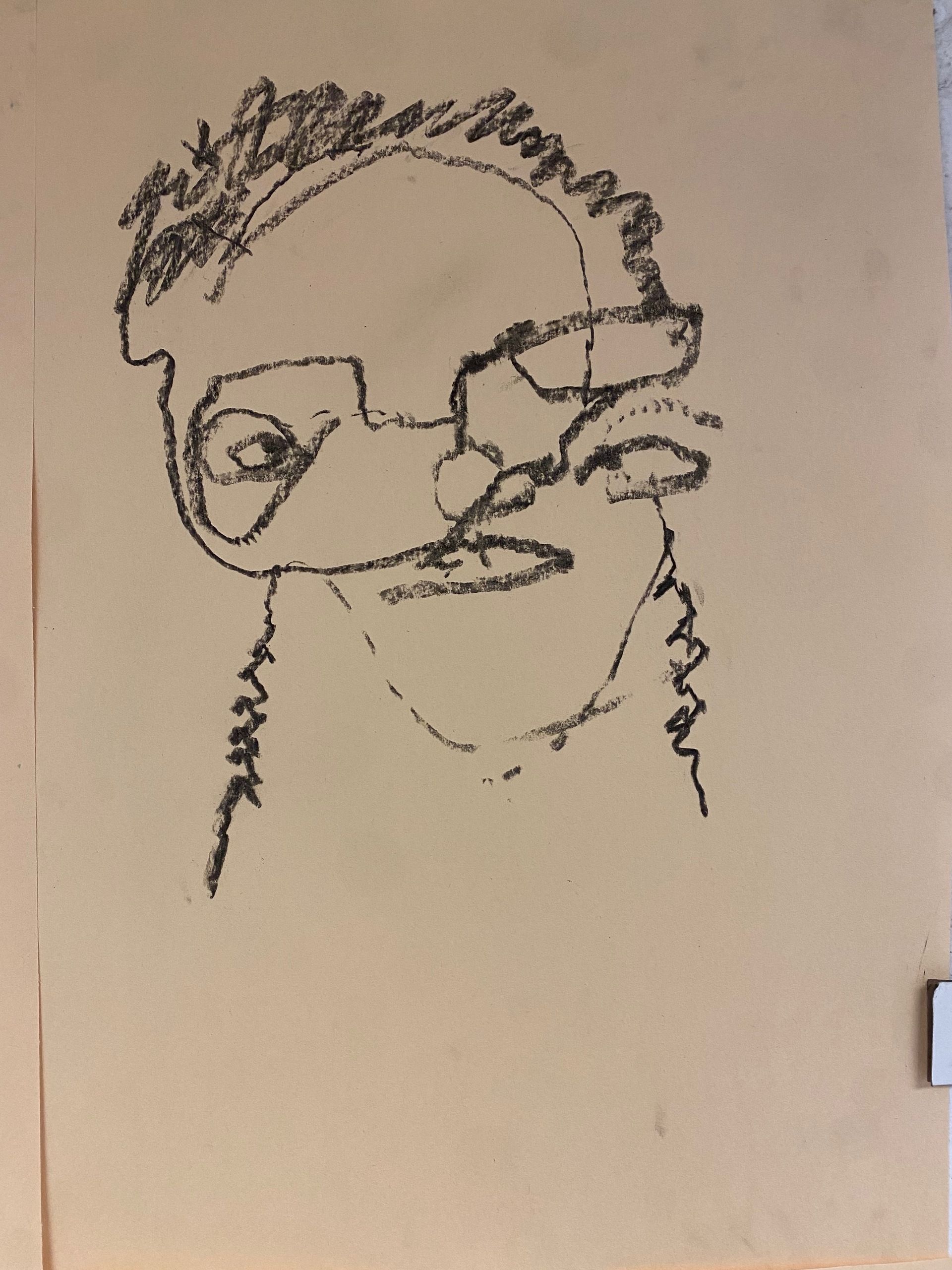
A felt self-portrait.
A New News Routine
I am trying something new (old): news in print. For months (really, years), I've been struggling with how to read the news. Obviously I care a lot about the world and I pay attention. But reading the news piecemeal, on social media or other sites on my phone, throughout the day, is bad for me personally and bad for me as a caring person in the world. It’s not a thoughtful, caring, or engaging way for me to consume—and, more importantly, digest, process, and sometimes act on—information.
So I'm trying to come up with better routines. Structures that allow me to engage with thoughtful media and journalism. I’m trying to make space to consume news and actually hear it—think and feel and respond to it. One strategy that’s working for me is print media. I subscribed to In These Times, and I’ve really appreciated both issues I’ve read. I know a monthly print journal isn’t as fast or immediate as online news, but I actually think this is beneficial (a lot of the time). Slowing down is not actually in opposition to liberation work, even though it feels that way sometimes.
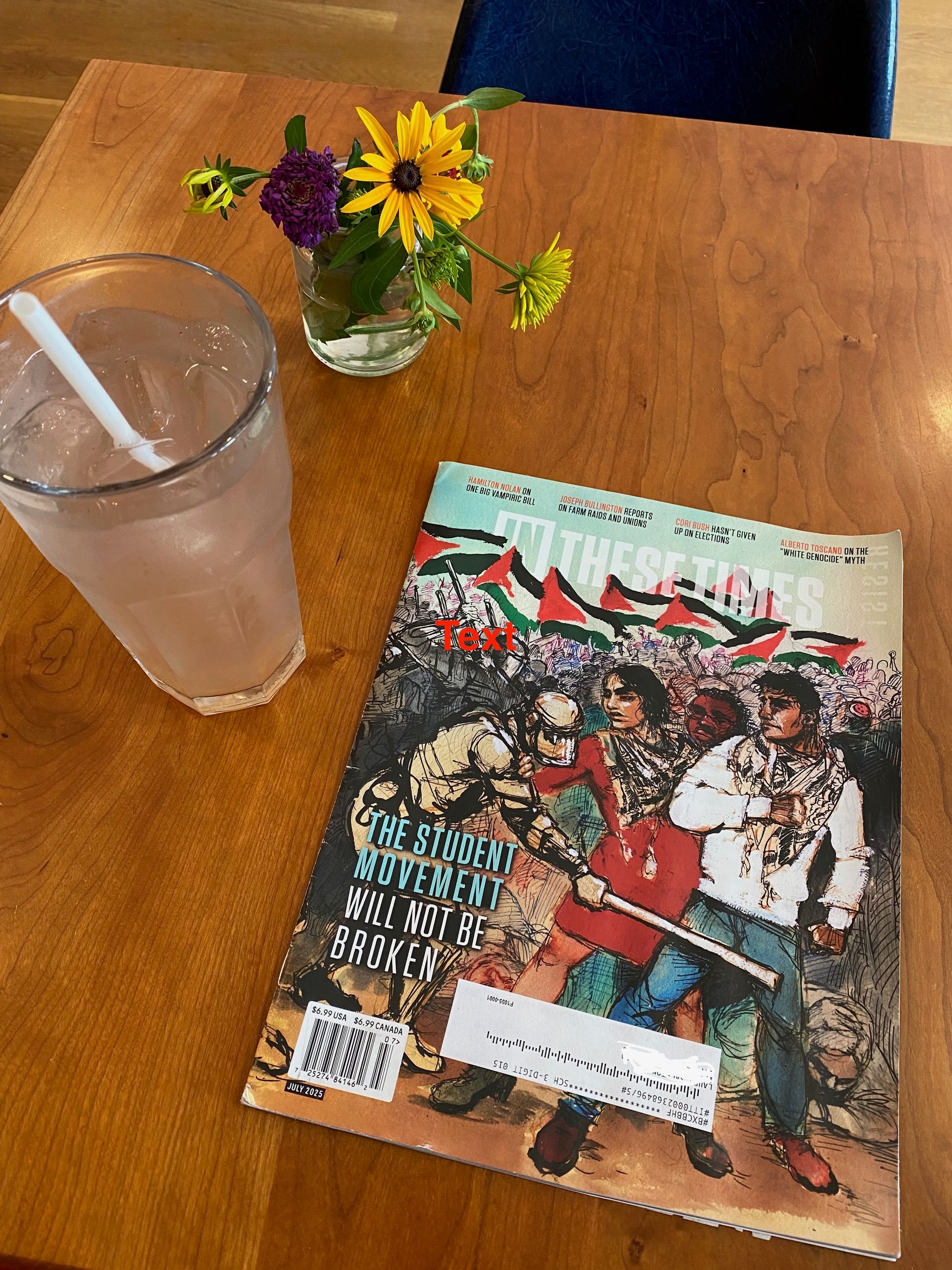
I still scroll. There’s still news I want to read online. This is a work in progress. But it’s a good work in progress. If you have any favorite leftist print media, please tell me about it! I’d honestly love to get a weekly paper, but so far I haven’t found one I want to subscribe to…
The Language of Friendship
In August, I sent and received a lot of voice notes. Based on a quick calculation, I spent about 12 hours listening to voice notes from friends. 12 hours! I didn’t add how much time I spent recording voice notes, but I’m guessing it’s a similar number. That’s about 24 hours of talking back and forth with pals. The enormity of this gift is overwhelming (complementary).
One sweet friend and I have been talking a lot about friendship—ours, but also friendship in general. We don’t really have a language for friendship, societally. If you meet someone you’re romantically interested in, there’s a framework. It’s expected and encouraged that you might talk about what you’re looking for in a relationship. You might talk about your communication styles, your love languages, whether you’re monogamous or not, if you’re looking for a partner to start a family with or someone to go to museums and have sex with occasionally. And even if you don’t talk these things, the framework still exists. Yes, talking about feelings is hard, and yes, we avoid it, but also, when it comes to romance, there’s language for it. When was the last time you had a conversation with a new (or old) friend about what you both want and need from your friendship? How do we talk about the pain of going through a friend breakup? No one gets bereavement leave for the death of a friend. The word friend itself feels slippery.
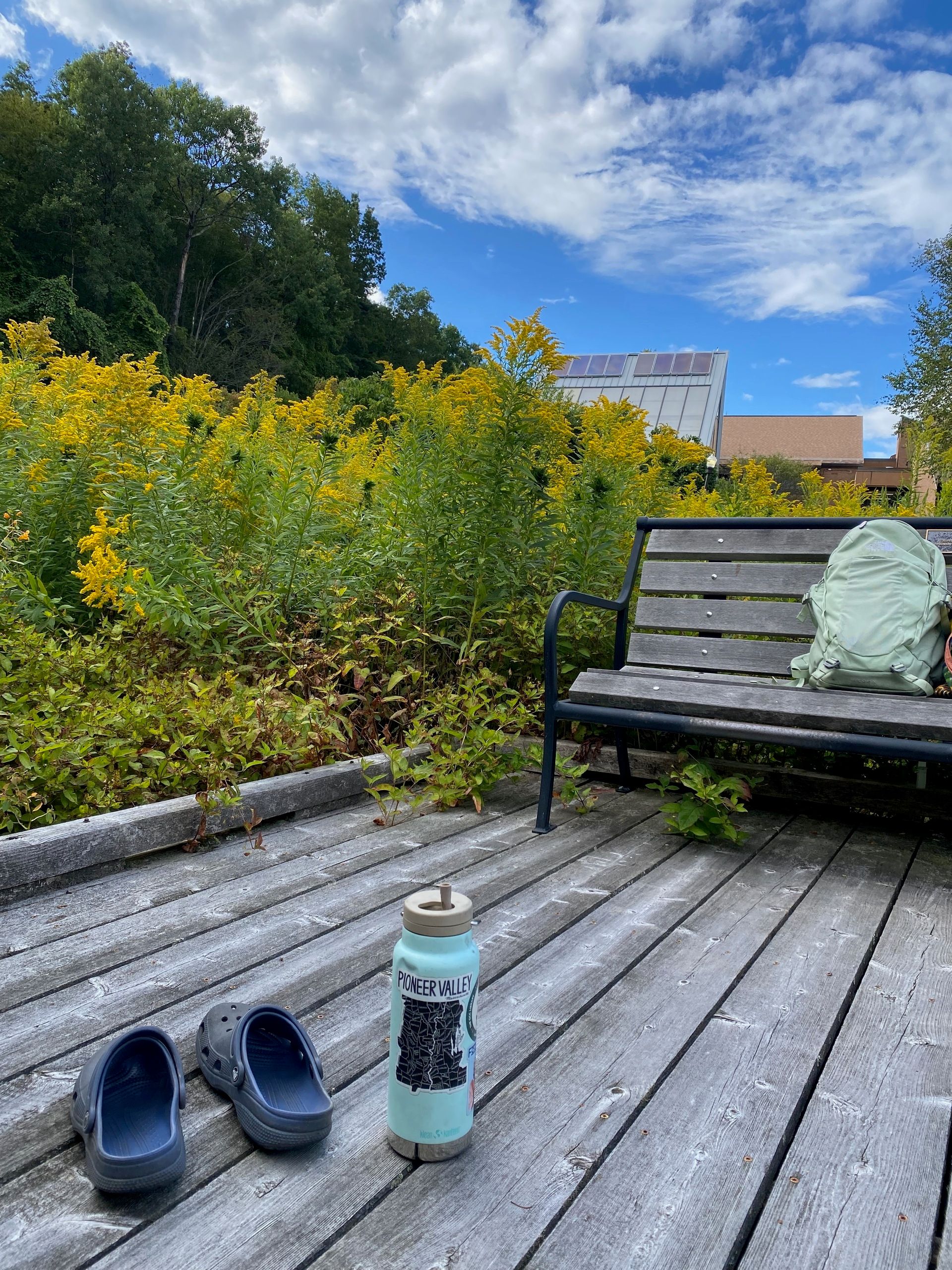
My voice note recording studio at school
This is all to say, I am trying to take relational risks, to be braver in my friendships, to ask for what I want and need and listen to what my friends what and need. Why can’t we use the language of romance to talk about friendship?
I’ve gotten in the habit of listening to and recording voice notes from this spot in the gardens at school, on a little boardwalk surrounded by goldenrod and cattails. I have a lot more I could say about the ways that voice notes have completely changed both my in-person and long-distance friendships, but it mostly boils down to: what luck. What luck, to get to co-create space across time zones for all this thinking and feeling and wondering and dreaming and holding.
My Place
I’ve been thinking a lot (always) about what it means to have a place. This summer I got really into getting ice cream at my local ice cream spot, Townline Ice Cream. It is, in fact, on the town line between Bernardston and Greenfield, but I call it “the place at the bottom of the hill” because I live on a big hill and Townline is, literally, at the bottom of it. I’ve lived on this hill for five years now, and while I’d been to the place at the bottom of the hill a few times before, I didn’t start thinking of it as “mine” until this summer. Often, I am slow to arrive. This is just a part of being me.
The place at the bottom of the hill is a less-than-ten-minute drive from my house. That’s about as close as anything gets in the rural hill town where I live. I can’t walk to anything from my house, but driving down the hill for ice cream feels like walking down the block. It’s easy, low stakes. In August I got into the habit of going for ice cream when I was craving being around people but didn’t really want to go anywhere. When I wanted the feeling of being in the world but was too tired to socialize or drive to an event. I probably went twice a week for a good chunk of the summer.
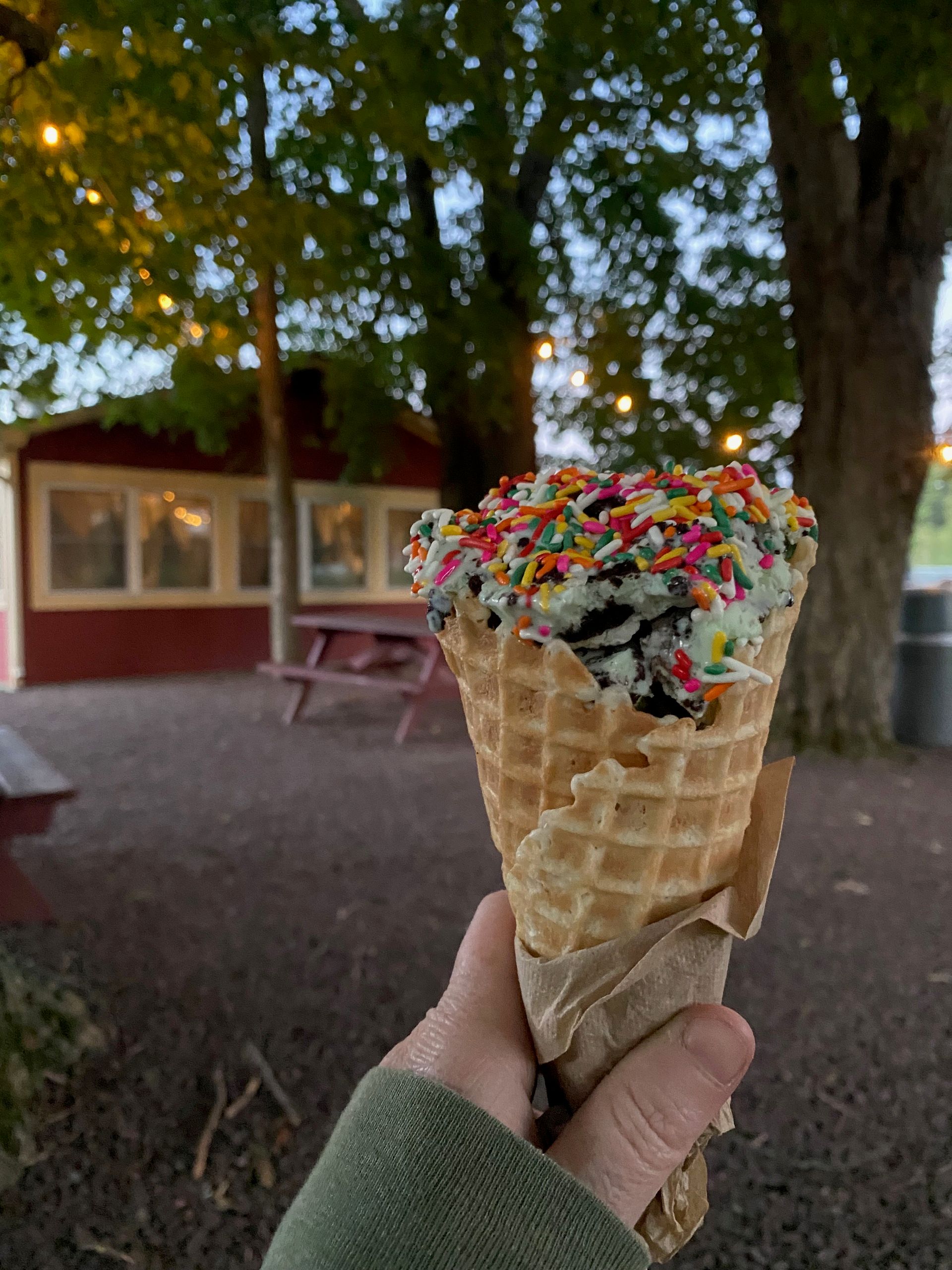
I do not order ice cream without sprinkles anymore. Why would you?
I like the scene at the place at the bottom of the hill. There’s a group of gorgeous old maple trees behind the stand. I like eating my ice cream under them. There are always people there—families, elderly couples, groups of queer folks, people on dates, little gaggles of teenagers, other people by themselves like me. It’s where everyone goes. There’s not a lot of places to go in the hill towns, so people go here. I like the feeling of being among. I don’t really live in a neighborhood, but this place is a neighborhood place. I hadn’t considered, until this summer, how much that sense of being in some kind of neighborhood matters to me. I feel closer to my place now.
Another meditation on my place: below is a view from the road I walk on most mornings. I have many, many photos from this exact spot, in different seasons. I love the way the trees frame the sunrise. I love watching the pasture change from spring to summer to fall to winter. When I think about my place, what it means to live where I live, this is one of the vistas I think of.
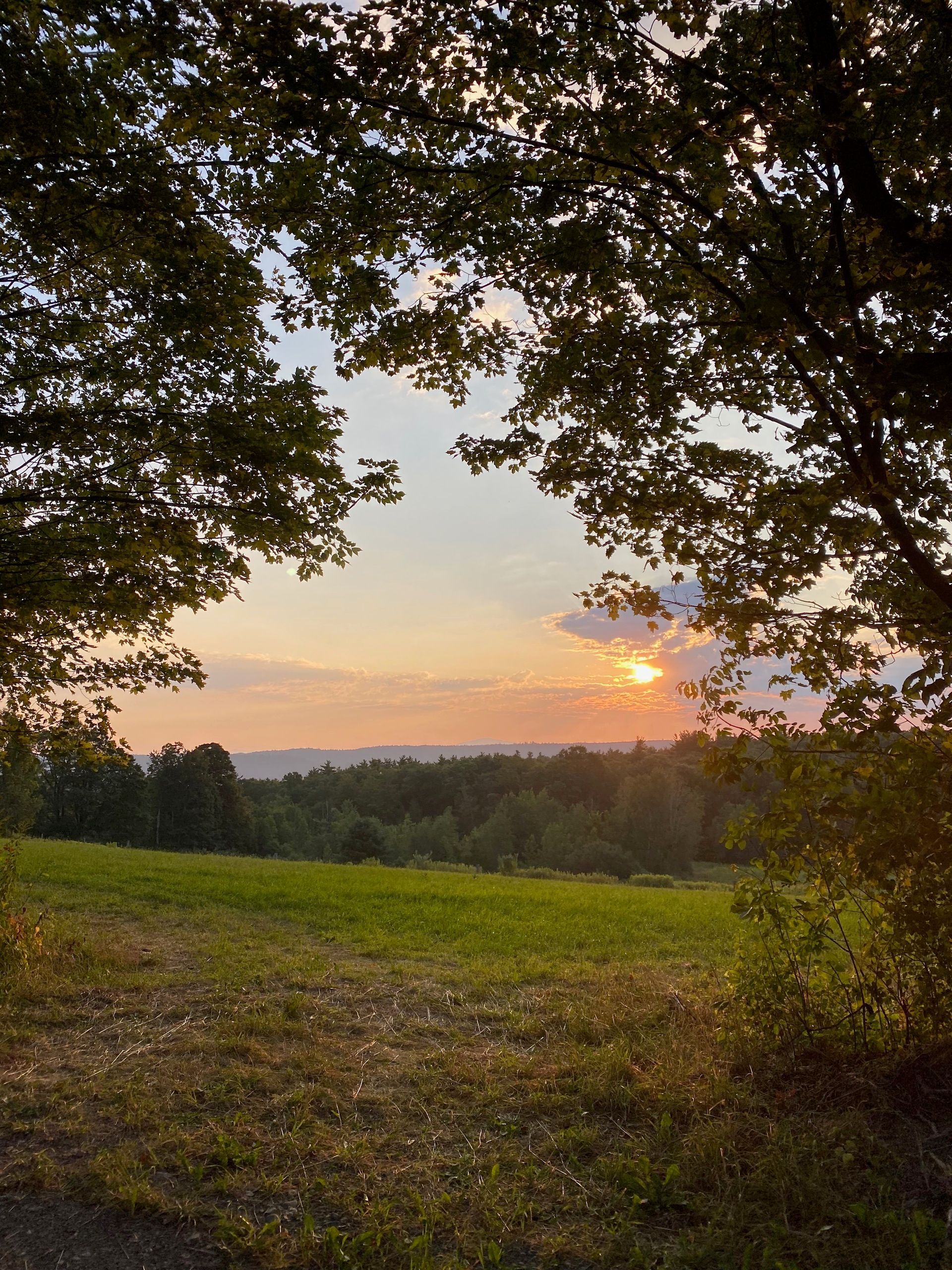
This next photo is a view from just a little further down the road, but I have almost no photos of it. It’s just a few minutes past the place on the road where I usually turn around. One day in August I just kept walking. The field I encountered stunned me. I have walked further down this road before, but long enough ago that I did not remember this particular vista. The newness of discovering something beautiful about a place I know well was disorienting and lovely. Why don’t I walk to this vista every day? What makes me turn around where I do?
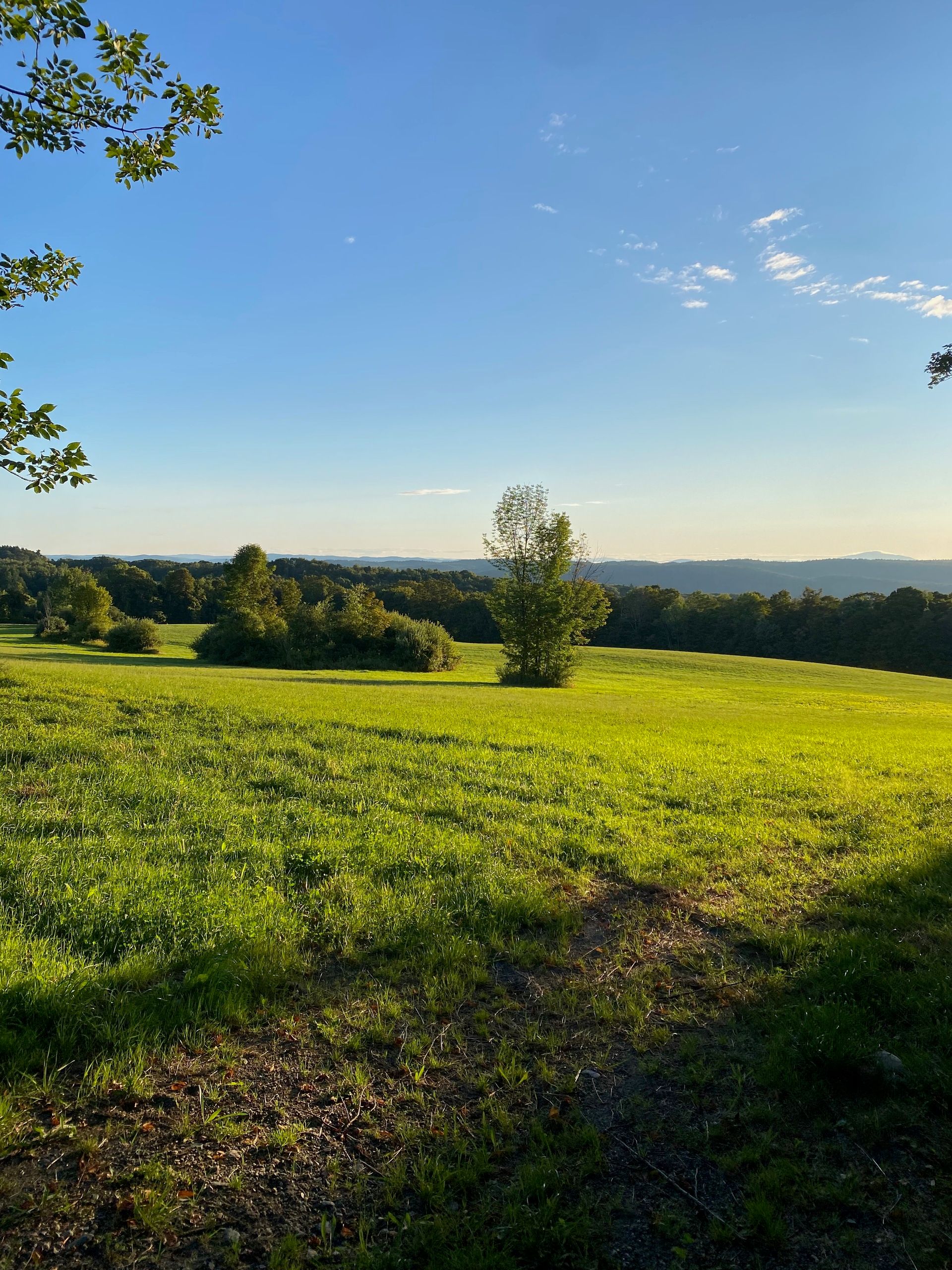
What does it mean to belong to a place, or, even, to unbelong to a place, to let go of belonging, to seek some other kind of connection? Where are the boundaries of my place? This is why I walk around in the woods, visit with trees, write poems, put myself into bodies of water, drive down the hill for ice cream: to tangle with the messy responsibility of having a place.
Untranslating Trees
I am always thinking about trees. Lately I’ve been thinking about how I can’t talk to trees. I am always trying to talk to trees, to listen to them. But I don’t know their language. I don’t think I will ever know their language. There is something complicated about loving beings so beyond my understanding that I haven’t been able to articulate to myself yet.
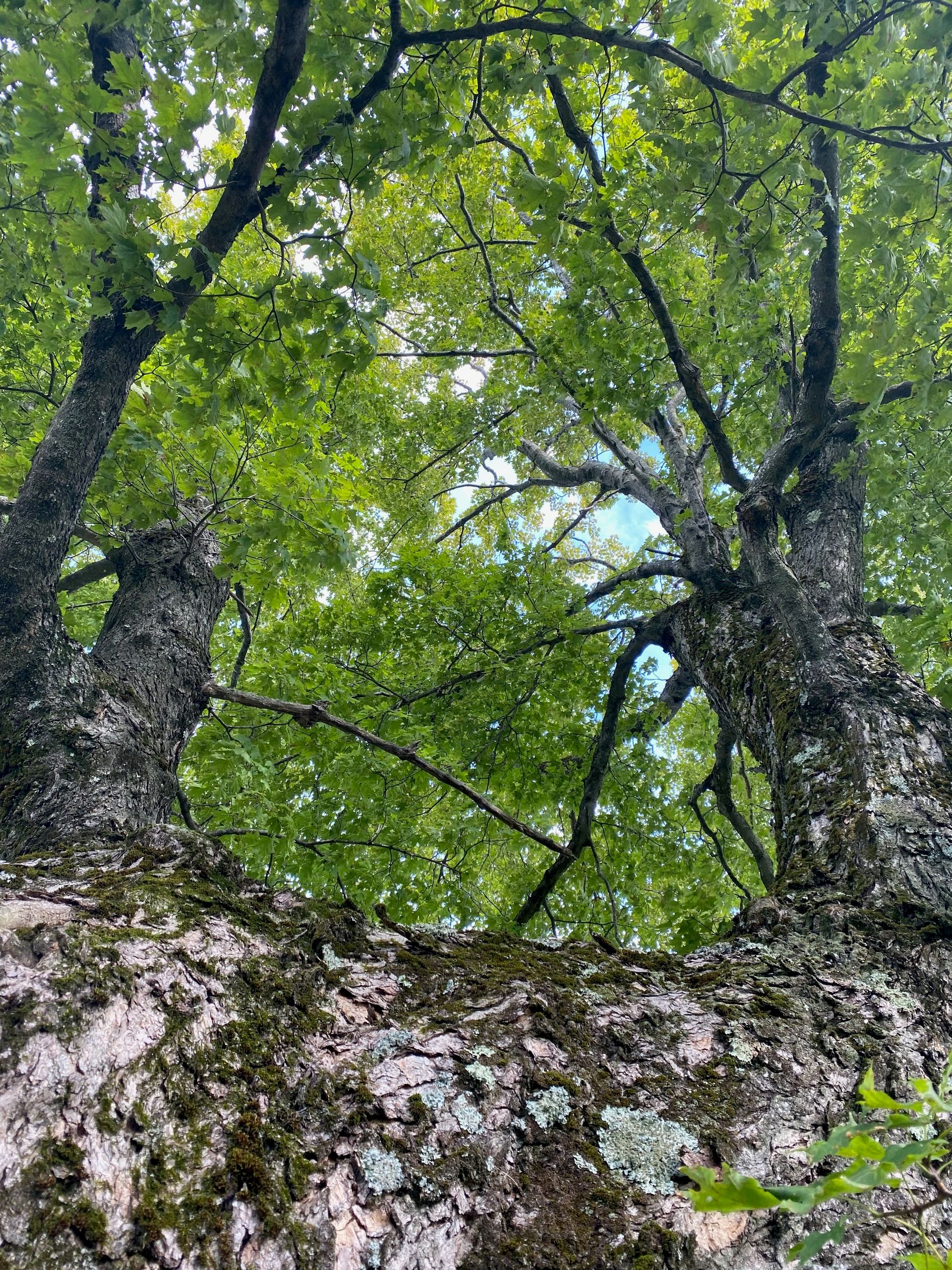
My favorite tree is an old sugar maple on the ridge. Every time I walk past it, which is most days, I put my hands on its bark. It’s a ritual. I’m not sure what it means, if it has a purpose. I just know it feels weird and wrong to walk past this tree without pausing to greet it.
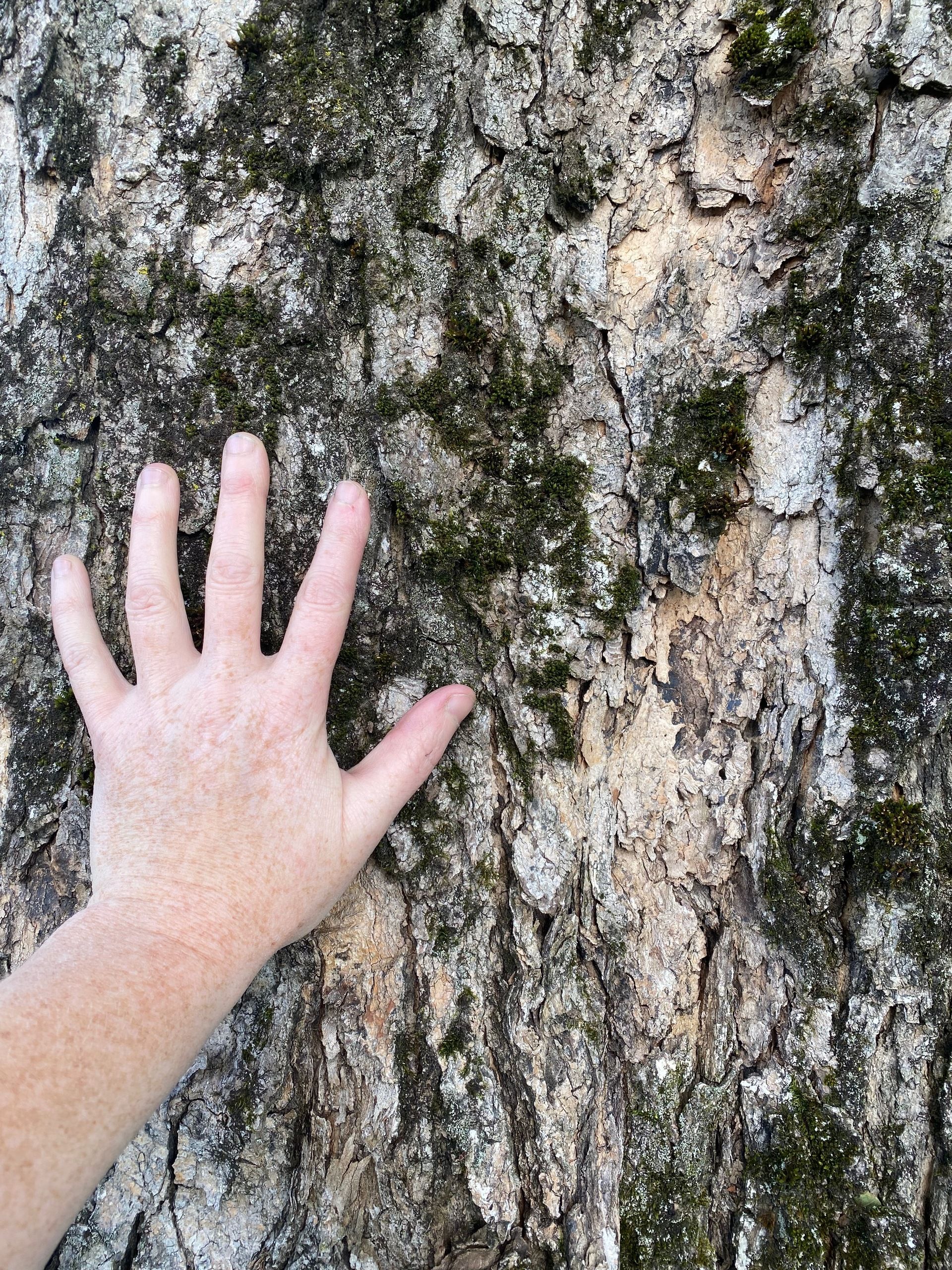
A Tiny Poem
I had a tiny poem come out in ONE ART on the last day of August. You can read it here (or below).
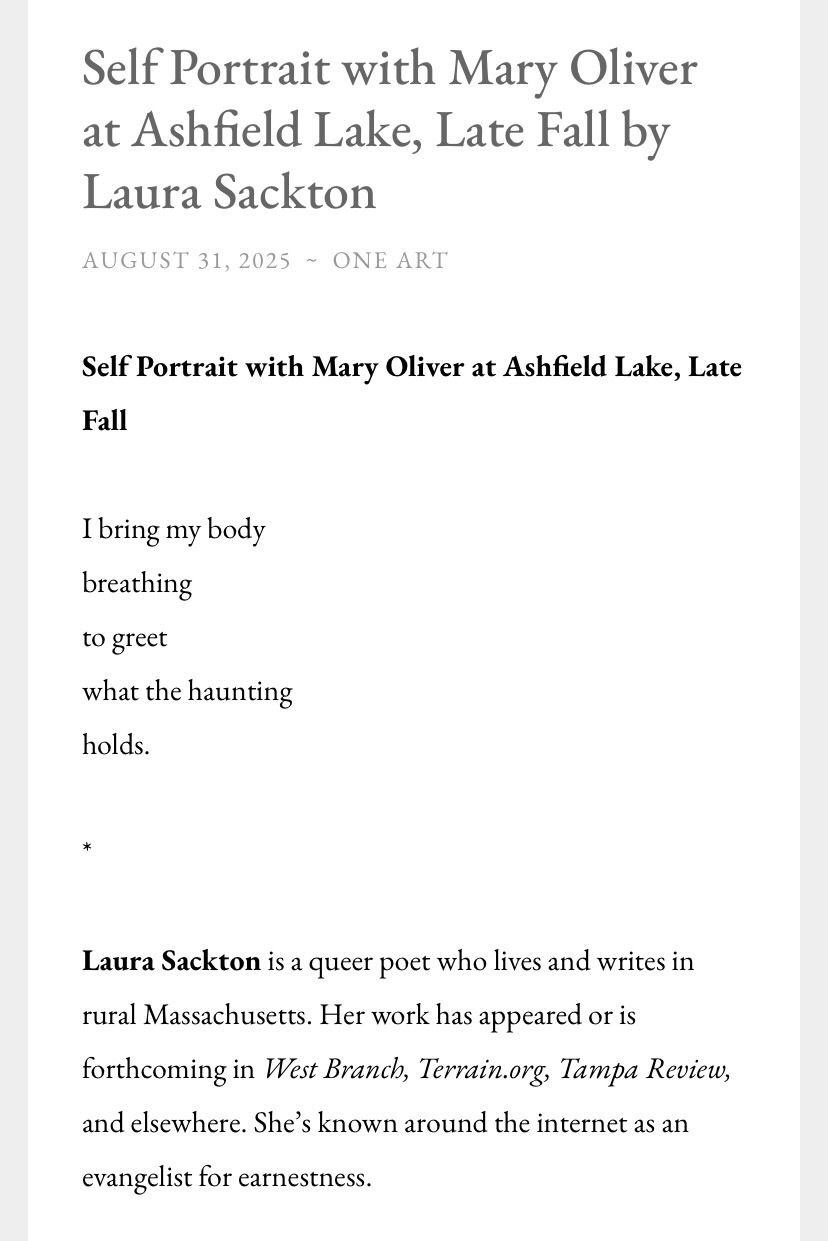
Words I’m Holding Close
Some lamps of beauty and wisdom from August that are lighting my way forward:
Love is the clumsy name we give to a body spilling outside itself. It is a category we have pieced together to make something like sense or reason out of the body failing to live up to the promise of self-sovereignty.
I fear the time
that has lost its heart
I’m not just a flower. At any given moment I’m also a weed and
medicinal and food for some bees and I don’t know, just a thing
in the wind, a thing
in the ground.
I will not turn away from the ache of this world. I’m trying to feel my feet. Let’s cry enough to submerge, up to our ankles at least. Don’t keep your grief from me.
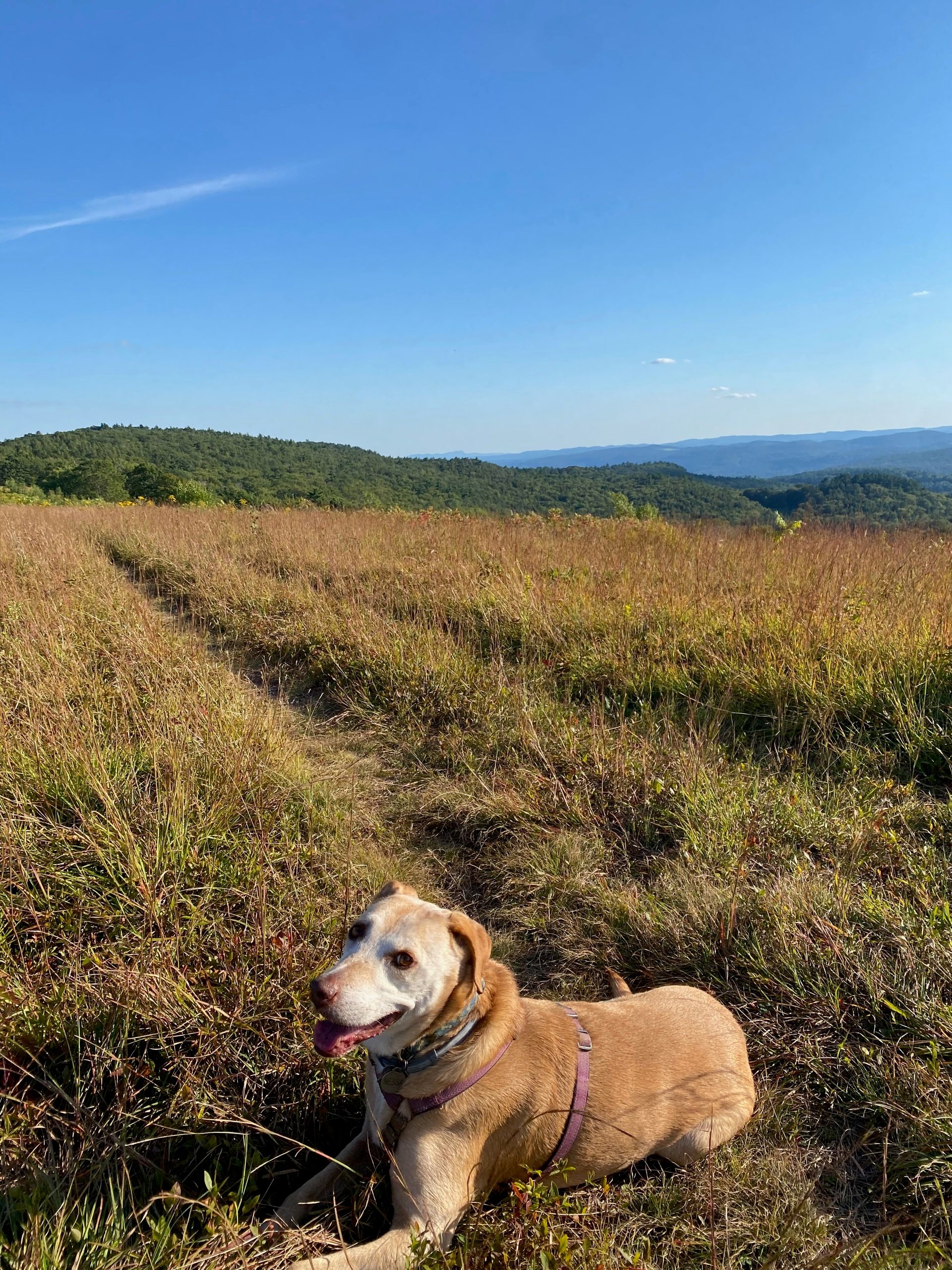
Thanks so much for being here, and for reading! I plan to send another newsletter next week, rather than next month, which means it will be a whole lot shorter!
Reply